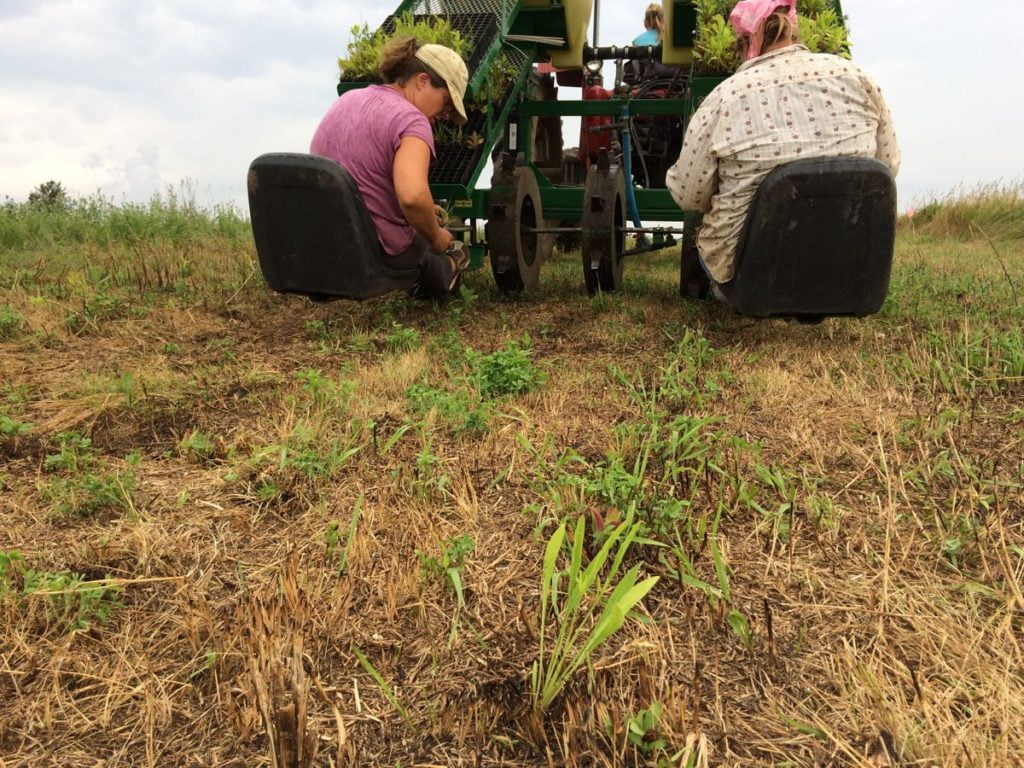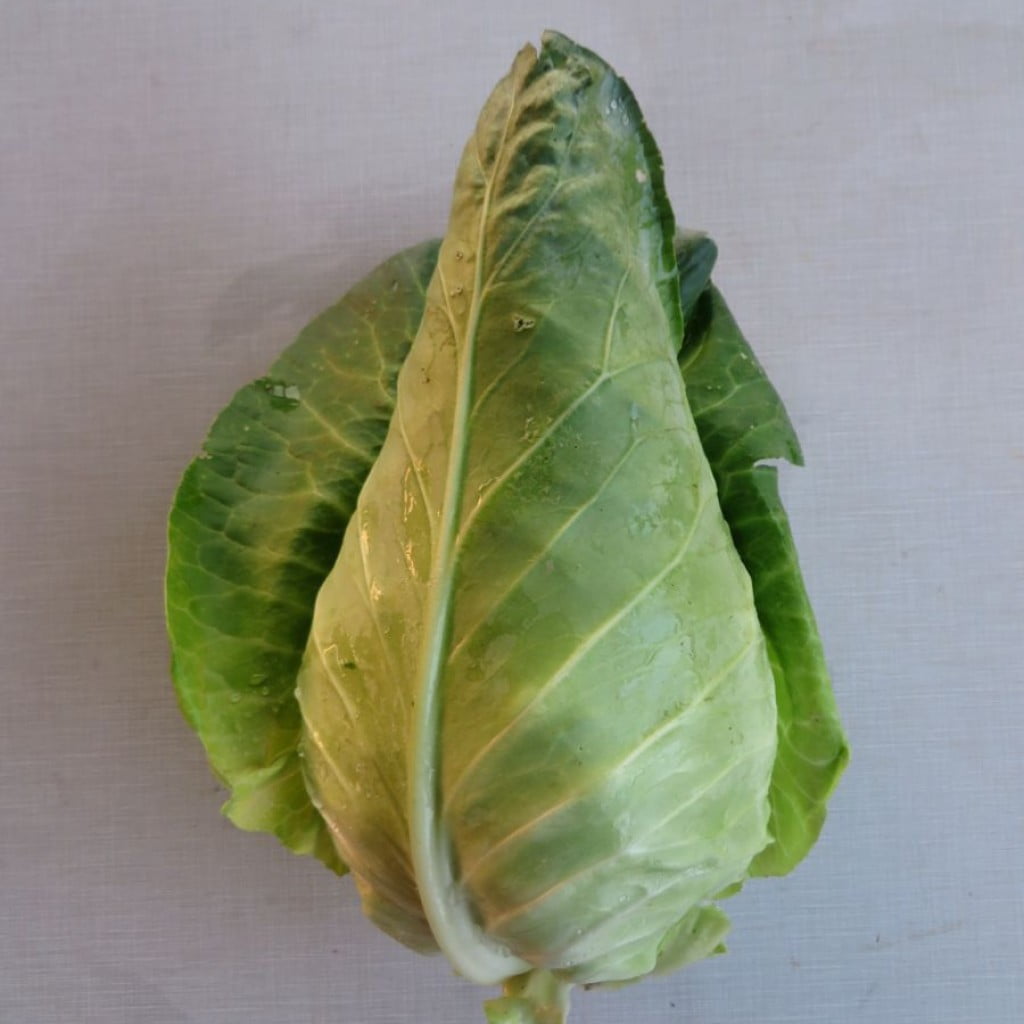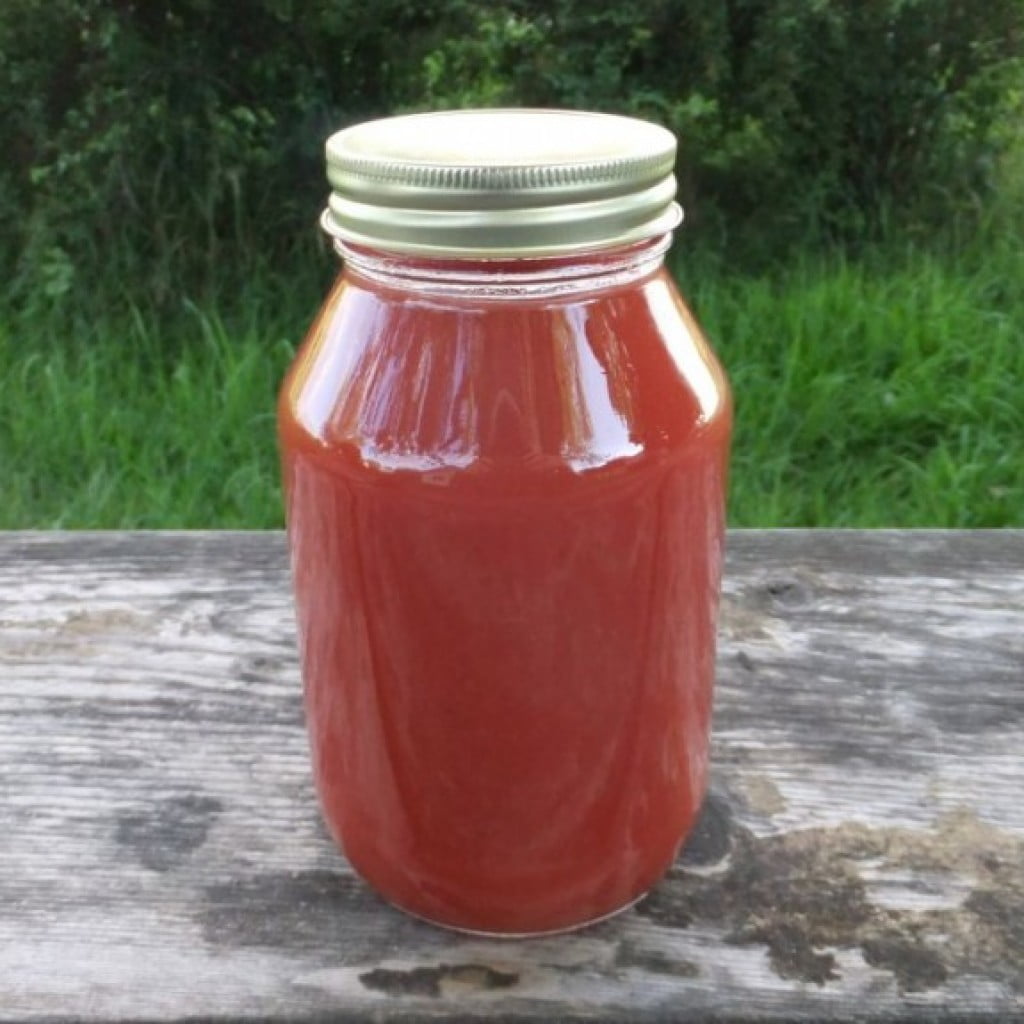Blog
Experimental Farm Habitat, week #12
- On: August 02, 2017
 0
0
I set out to establish an experimental patch of prairie this year. Interspersing natural areas among our fields is an important practice of organic farming. Our farm has a lot of land that is not in crops, mostly grassy field roads and untilled hills planted to alfalfa. However, much of it is not quality habitat. The blooming species are limited and the hills are getting overgrown with introduced grasses. We need to do better. Our goal is to have a long season of flowers to support our bees and the beneficial insects that protect our crops. They are important pieces of the puzzle of organic farming.
Hiring Kristen Knoener abetted my interest in prairie. She has many years experience working for a prairie restoration company. She and I talk endlessly about prairie. Thank goodness she’s here because Steve will no longer discuss prairie with me. He’s heard enough.
Most modern prairies are established with heavy herbicide use, especially if weeds are already present. Read extension manuals and they say “it can’t be done without herbicides.” This cannot be true! I began reading last winter and discovered there’s belief among biologists that prairie can be established using just fire to suppress introduced weeds. I joined the local Prairie Enthusiasts chapter and found they are experimenting with the same idea. There are tricks, such as burning in late spring, an unusual time of year but effective against some difficult weeds. It also helps if you keep your expectations low.
Last fall, I collected seed from friends’ land and nearby prairies. This spring, we started 2000 prairie seedlings in our greenhouse, using the same techniques we use to grow our vegetable seedlings. In early July, we burned a small strip at the edge of a fallow area. Kristen and friends with burning experience came to show us how to do this properly. We planted more seed using our vacuum seeder, the one Steve plants carrots with. Finally, we transplanted our seedlings in mid-July. The timing was perfect, sandwiched between two substantial rains. The plants are already growing strongly.
Will this work? We are using an unusual technique. I plan to keep my expectations low and will be content if we achieve a long season of bloom even if mixed with weedy species. It will not be picture-perfect prairie but that’s OK. It will make our farm a healthier ecosystem and a prettier place to live. Wish us luck! Beth

Even weedy areas can support bees and other pollinators. Most of the blooming plants in this photo are introduced species that linger on the edges of our farm. This little flowering strip bisects our farm and stays in bloom for almost two months. It buzzes with bees from nearby hives.
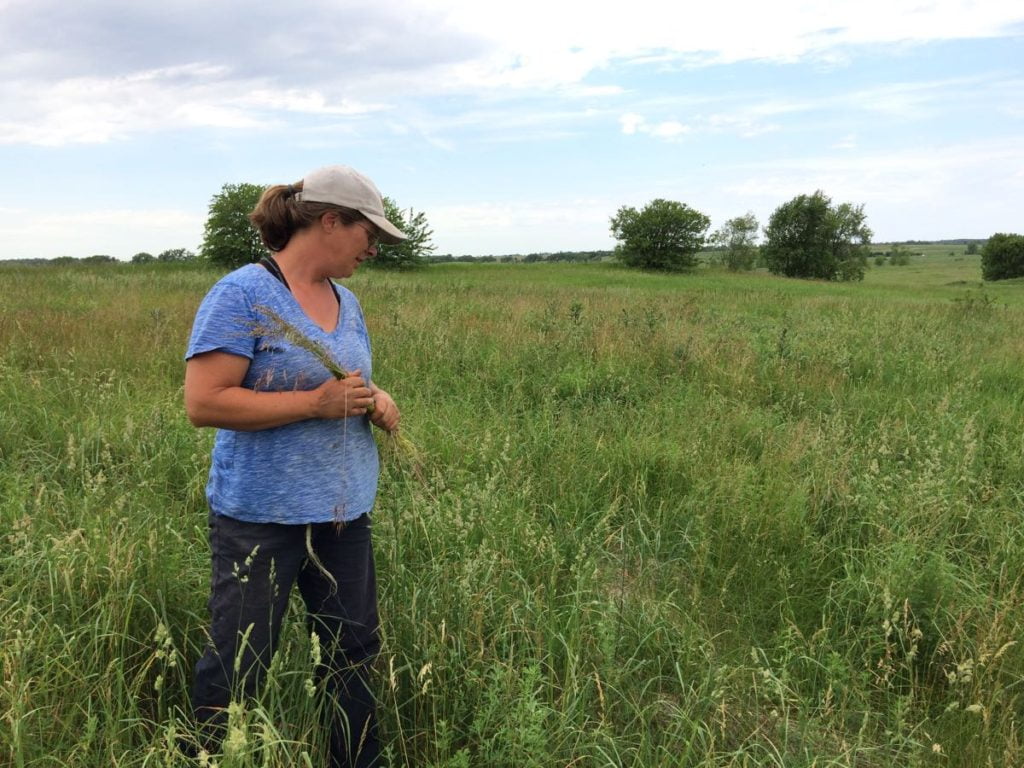
Kristin looks through the area we chose to work in. We seeded this field to alfalfa 15 years ago but grasses have crept in. It’s a daunting area. That’s why this is an experiment.

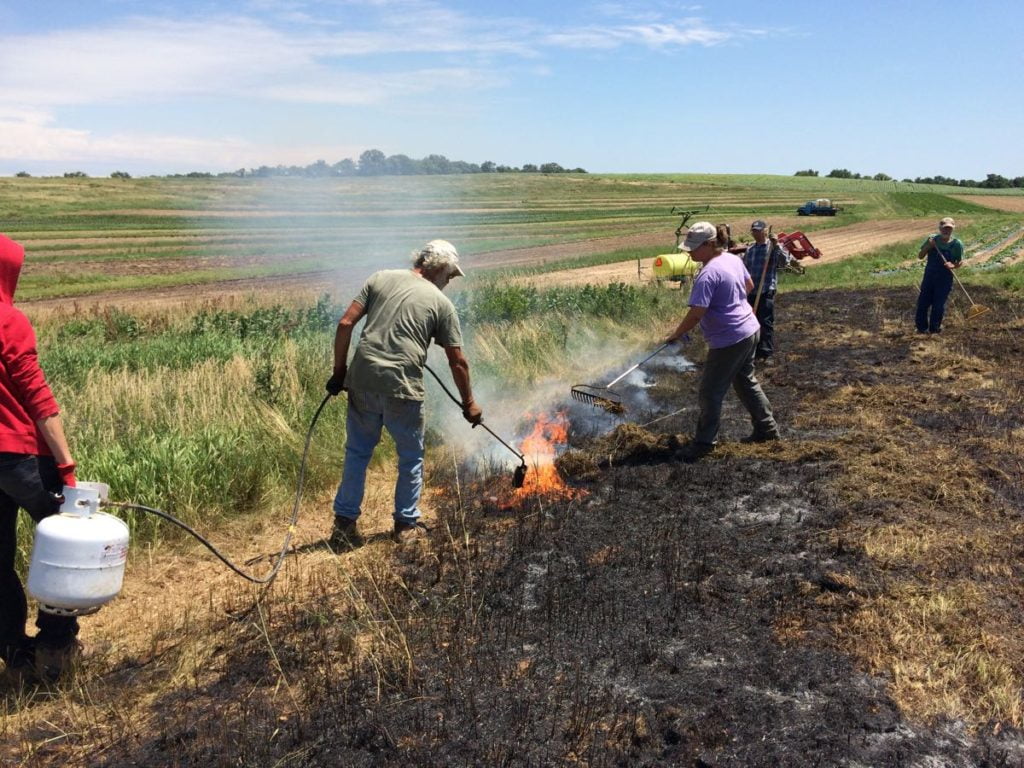
We burned the area in early July. Top, Kristin’s friend Nate Gingerich carries a water can, I move the fire around with a rake and Steve checks the edge. Bottom, Ari, Steve and Kristin clean up unburned patches. Nate and John Ischner in background.

We added seed, using our expensive vacuum seeder. We own many tools for growing vegetables and may as well use them for this project.
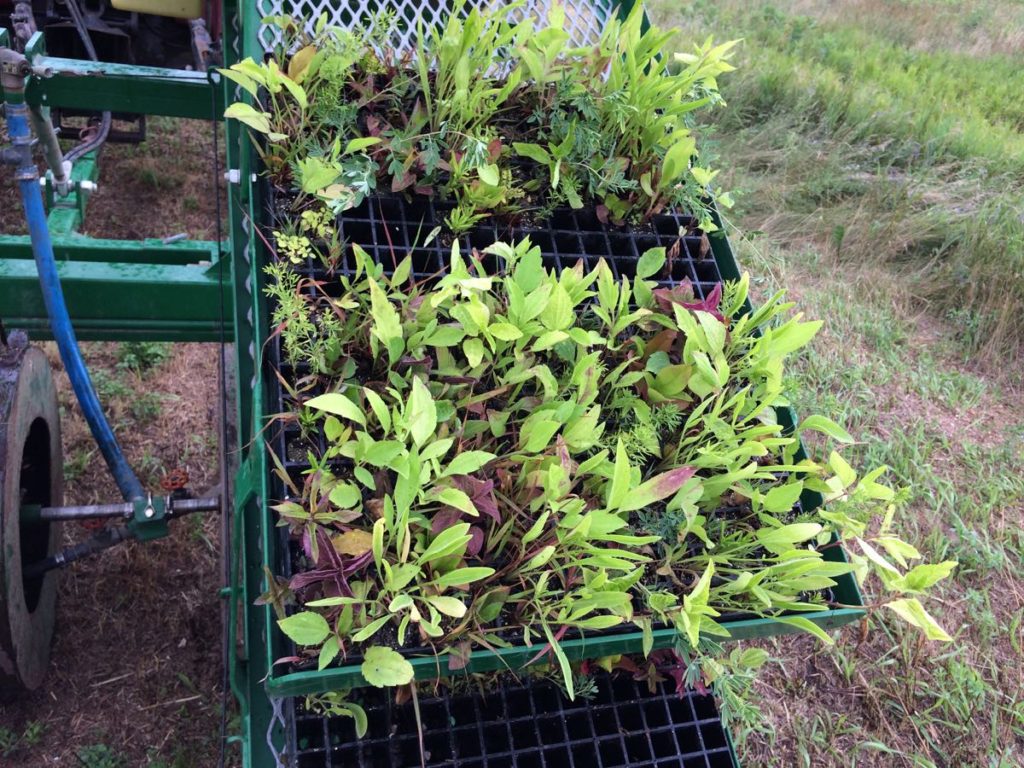
Mixed flats of greenhouse-grown prairie seedlings.
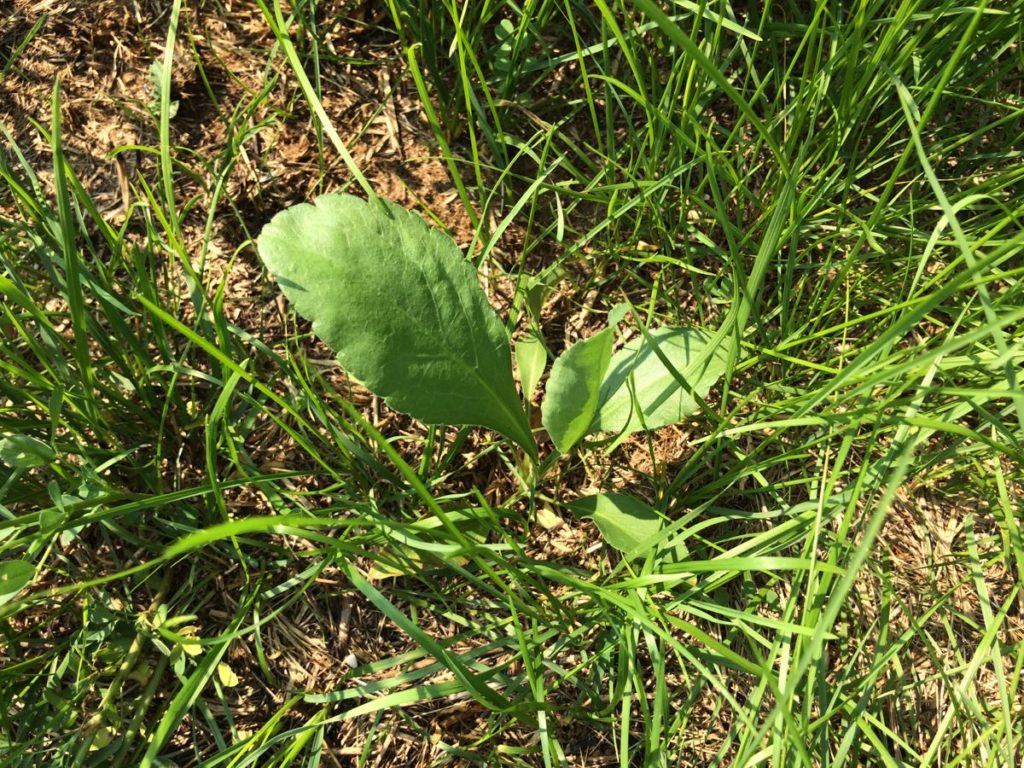
Three weeks later, the seedlings have already grown a lot! The alfalfa and grasses are growing back too (as expected). We’ll try to manage those by mowing and burning again next spring.

If you are interested in prairie restoration, this is a terrific book.
Veggie List and Veggie Notes (Aug 3/4, 2017, green EOW)
Treat this as an approximate list. We’re not sure each box will have all the items.
Sweet corn, 9-10 ears
Green beans, ~0.9 lb
Broccoli, 1 or 2 heads
Tomatoes, 2 or 3
Frying OR bell pepper, 1
Cherry tomatoes, 1 pint
Zucchini/summer squash, 1
Salanova lettuce, 1 small
Red onion
Walla Walla onion
Garlic, 1 bulb
Italian basil, 1 husky sprig
Some sites get watermelon.
Some sites get muskmelon.
Next week’s box will probably contain melon, green beans, tomatoes, peppers, cucumbers, onion and more.
Sweet corn – Be prepared to cut off the tips of your corn. Almost all the ears have damaged tips, from bugs or birds or rain driving water into the tip. Sorry about that. Just chop the tips off before you peel the ears.
Green beans – Our beans are unusually late this year because we lost the first planting during cool, damp weather in May. Anyway, enjoy these first beans.
Tomatoes – You will get 2 or 3 plum or slicing tomatoes.
Salanova lettuce – The lettuce heads are small. We harvest lettuce small this time of year, before they get bitter or too big to fit in the CSA boxes. This is the ‘Salanova’ variety that falls apart into salad mix when you cut the head at the base.
Onions – We’re sending two types of onions this week. They are easy to tell apart. Everyone receives a sweet Walla Walla onion, the type we have sent in recent boxes. Wallas are best used raw. We are also sending a red onion so you have an onion that will fry well. They are also good raw but are more pungent than Walla Wallas.
Garlic – This week’s organic garlic is from our friend John Hendrickson at Stone Circle Farm.
RECIPES
Visit our Recipe Log, a list of all our 2017 recipes to date.
RECIPES FROM LOCAL THYME
Comforting Classics
Melon Granita
High Summer Vegetable Soup
Spice Rubbed Chicken and Zucchini, Pepper and Onion Tacos with Chipotle Cream
Beef or Cashew Broccoli Stir Fry
Outside the Box Recipes
Chilled Melon Soup with White Wine and Basil
Green Beans with Caramelized Red Onions
Triple Chocolate Zucchini Dessert Muffins
Roasted Broccoli with Pancetta
Quick and Easy Meal
Chopped Salad with Basil Buttermilk Dressing
RECIPES FROM LAUREN
GRAIN SALAD WITH BROCCOLI, BEANS & BASIL
Also known as the grain salad I’ve been attempting to make my whole life adapted from this Bon Appetit recipe
After making this grain salad, I finally realized what I’ve been doing wrong all along. Not enough veggies. Too much quinoa. No dressing. With the perfect balance of crunchy veggies (some raw, some blanched), nuts, grains and herbs, this grain salad has changed my life and I can’t wait to make it again and again. Lauren.
1/3 cup quinoa
2/3 cup water
2 teaspoons Kosher salt, divided
3/4 pound beans, ends trimmed
1 head broccoli, roughly chopped into bite-size pieces
1/4 cup diced Walla Walla onion (about 1/4 of one onion)
1/2 cup shelled, toasted pistachios, divided
1/2 cup coarsely chopped basil (about 1/2 of the leaves from your sprig)2
5 tablespoons olive oil
2 tablespoons white wine, chapagne or rice wine vinegar
1 tablespoon maple syrup (or brown sugar)
2 teaspoons Dijon mustard
1/4 teaspoon Kosher salt
1/4 teaspoon freshly ground black pepper
- In a small sauce pan combine quinoa, water and 1 teaspoon salt. Bring it to a boil, reduce to a simmer and cover. Cook for 15-20 minute until most of the liquid has been absorbed.
- In a separate large pot, bring water to a boil over high heat with remaining salt. Once boiling, add beans and cook for 2 minutes. Drain and rinse with cold water. Let sit in the colander while you prepare the rest of the meal.
- In a large bowl, combine cooked quinoa, blanched beans, broccoli, and Walla Walla onions.
- In a food processor, combine 2 tablespoons pistachios, basil, olive oil, vinegar, maple syrup, mustard, salt and pepper. Process until dressing comes together. It should be pale yellow and very creamy. If you don’t have a food processor, you can whisk the ingredients together in a bowl. Just make sure you very finely chop the 2 tablespoons of pistachios first!
- Pour dressing over quinoa and veggies. Add remaining pistachios and stir until dressing coats everything evenly. Taste and adjust seasonings as needed.
.
TOMATO & BASIL PIZZA
This is an attempt to recreate a pizza I had at Sal’s in Madison a few weeks ago that my husband and I dubbed the best pizza we’ve ever had. It’s not quite as good as the real thing (because I have yet to master a crust that good), but it’s darn close. I love the combination of sweet, salty, creamy, and spicy. Lauren.
Takes 90 minutes (if making dough from scratch), 50 minutes with store-bought crust
Serves 4-6
1 batch favorite pizza dough, I used this recipe but wish I would have planned ahead and made this one a couple days in advance (it’s way better!)
1 head garlic
1 tablespoon olive oil, plus more for drizzling
1 Italian fryer pepper
1 pint cherry tomatoes
1/2 teaspoon Kosher salt, plus more to taste
1/4 teaspoon freshly ground black pepper
1-1/2 cups whole-milk ricotta cheese
15-20 pepperoni slices
1/2 red onion, thinly sliced
1/2 teaspoon red pepper flakes, plus more to taste
1/2 cup shredded mozzarella cheese
15-20 basil leaves (about half sprig)
- Prepare dough if making from scratch. Leave to rise on the warm oven.
- Preheat oven to 350 degrees (I always usually use the toaster oven for this step to avoid turning the whole oven on early).
- Cut the top off the garlic and remove any excess paper (the stuff around the cloves is fine but remove the paper surrounding the whole bulb). Set on a piece of aluminum foil. Drizzle with olive oil slowly so it soaks into the garlic. Wrap the entire bulb in the aluminum foil and roast for 35 minutes until softened. Remove from oven and allow to cool.
- Preheat broiler of oven.
- Drizzle olive oil on a sheet pan. Add Italian fryer and pint of cherry tomatoes. Sprinkle with salt and pepper. Broil for 10-15 minutes until charred all over and tomatoes have burst. Let cool and then slice Italian fryer, scooping out seeds with a spoon when you get to the top.
- When the pizza dough is doubled in size, roll out to approximately 10×14-inches in size and transfer to a baking sheet. Spread ricotta over crust with a spatula. Sprinkle pizza with pepperoni, sliced onion, cherry tomatoes, sliced Italian fryer and red pepper flakes. Scoop garlic out of the skin with a spoon and place all over the pizza in dollops. Top with mozzarella. Bake 10 minutes. Remove from oven, add basil leaves, a drizzle of olive oil and another sprinkle of Kosher salt. Bake 5-10 minutes longer until both the crust and cheese is golden brown.
- Serve hot with more red pepper flakes based on your desired heat level.
Week #11, July 27 2017
- On: July 26, 2017
 0
0
Veggie List and Veggie Notes
(July 27/28, 2017, week #11, purple EOW and moon Sampler)
Sweet corn, ~6 ears
Green bell pepper, 1 small
Walla Walla onion
Cucumbers, ~2
Carrots, 2 lb
Kale, 1 bunch
Cherry tomatoes, 1 pint
Tomatoes, 2 or 3
Globe eggplant, ~1 lb
Red leaf lettuce
Zucchini/summer squash, ~2ct
Some sites get another cucumber.
Some sites get broccoli.
Some sites get another ear of corn.
Some sites get another pepper.
Next week’s box will contain sweet corn, melon, tomatoes, peppers, onions, broccoli and more.
Sweet corn – Storage. Sweet corn is best when fresh, so we encourage you to eat it asap. Store in the refrigerator, in the husks if you have the room.
Cooking. It is quicker to steam sweet corn than to boil it.
1.) Stand ears of corn upright in a tall pot. Put one inch of water in the pot.
2.) Bring the water to a boil. If the corn is cold when you begin cooking, steam for 5 – 6 minutes. If the corn starts at room temperature, steam for 4 – 5 minutes. The cooking time will vary somewhat depending on how many ears are in the pot. Pay attention to how the corn smells. The scent changes once the corn is ready. Another clue: water will bead on the corn until it is cooked. Don’t overcook it.
Globe eggplant – Storage – Eggplant will store unrefrigerated for 3 to 4 days on your kitchen counter. If you need to store longer, keep in the warmest part of your fridge. Eggplant does not store well for long periods of time. Both our cooks included eggplant in recipes this week.
RECIPES
Visit our Recipe Log, a list of all our 2017 recipes to date.
RECIPES FROM LOCAL THYME
Comforting Classics
Ratatouille Provençal
Beer, Ham and Cheese Chowder
Slow Roasted Kale Chips
Creamy Corn
Outside the Box Recipes
Eggplant and Meatball Tagliatelle
Slow Roasted Carrots with Harissa Yogurt
Marinated Kale and Carrots with Quinoa
Fresh Tomato Pesto Pasta with Corn, Broccoli and Peppers
Quick and Easy Meal
Hummus, Cucumber, Tomato, Lettuce Wraps
RECIPES FROM LAUREN
SUMMERTIME GREEN CURRY
Serves 4-6
Takes 50 minutes
1 cup brown rice
1-1/4 cup water
1 teaspoon Kosher salt
1 tablespoon butter
1-2 tablespoons green curry paste
1/2 Walla Walla onion, diced
1-inch ginger, peeled and minced
1 eggplant, quartered and thinly sliced
1 green bell pepper, thinly sliced
1 head broccoli, cut into bite-sized pieces
1 tablespoon maple syrup
1 13.5 -ounce can coconut milk
2 cups chicken (or vegetable) stock
Fish sauce, soy sauce or tamari, optional
Lime juice, optional
- In a medium saucepan, combine rice, water and salt. Bring to a boil, then cover and reduce to low. Cook for 45-50 minutes.
- Meanwhile begin your curry! In a large stock pot, melt butter over medium heat. Add curry paste and cook for a minute until fragrant. Add onion and ginger. Saute for 4-5 minutes over medium heat until onions are just beginning to brown and bottom of pan looks dry. Add eggplant, green pepper, broccoli and syrup. Cook for 5-10 minutes until vegetables soften.
- Add coconut milk and stock. Bring mixture to a boil, reduce to simmer and cook gently for 10-15 minutes.
- Serve over rice with a splash of fish sauce, soy sauce or tamari as well as a generous squirt of lime juice.
.
ZUCCHINI, SWEET CORN & TOMATO CAKE
Takes 1 hour
Serves 4-6
1 cup sliced tomato, about 1-2 tomatoes
3 cups sliced zucchini and summer squash, about 2 medium summer squash
1/2 Walla Walla onion, thinly sliced
1/2 cup sweet corn, removed from ear (no precooking necessary), about 2-3 ears
1-1/2 cup cornmeal
2 tablespoons sugar
1 teaspoon Kosher salt
1/2 teaspoon freshly ground black pepper
1 teaspoon baking powder
2 tablespoons butter
1-1/4 cup milk
2 eggs
1/2 cup parmesan cheese
400 degrees, 35 minutes
- Preheat oven to 400 degrees.
- Prep you veggies. Start with the tomatoes, slice them and lay them on a paper towel or cloth with a pinch of salt to drain some of the juice out while you work on the other veggies.
- Combine cornmeal, sugar, salt, pepper and baking powder in the bowl of a stand mixer or other large bowl.
- Combine milk and butter in a small pan. Heat it over high heat until it just begins to simmer and then pour into bowl with cornmeal. Let it cool for a couple minutes, then add the eggs. Stir until well-combined and smooth, scraping down the sides a couple times with a spatula, and then add all the veggies. Fold in gently. It’s ok if they get beat up a little bit.
- Pour the mixture into a greased 9×9 square pan or 10-inch pie pan and smooth with a spatula.
- Bake for 30 minutes. Remove from oven, add parmesan and bake 5-10 minutes longer until center is set. Serve warm.
Week #10, July 20 2017
- On: July 20, 2017
 0
0
Farm News
It has been a very wet week for us, as for most of you. We did not suffer damage in the thunderstorms and hope you didn’t either. All our fields are wet so we’ve had to grab opportunities between storms to do our field work. What else can we do?? We have to be ready for any window that opens. A big concern with wet weather is disease. If the weather dries for a few days, things will be fine. If it keeps raining, we’re sure to see diseases developing. Let’s hope for the best. Beth

Maggie and others weed Brussels sprouts. First harvest isn’t until October but we must keep them weeded. The woman of mystery is Charlotte in her mosquito net shirt.
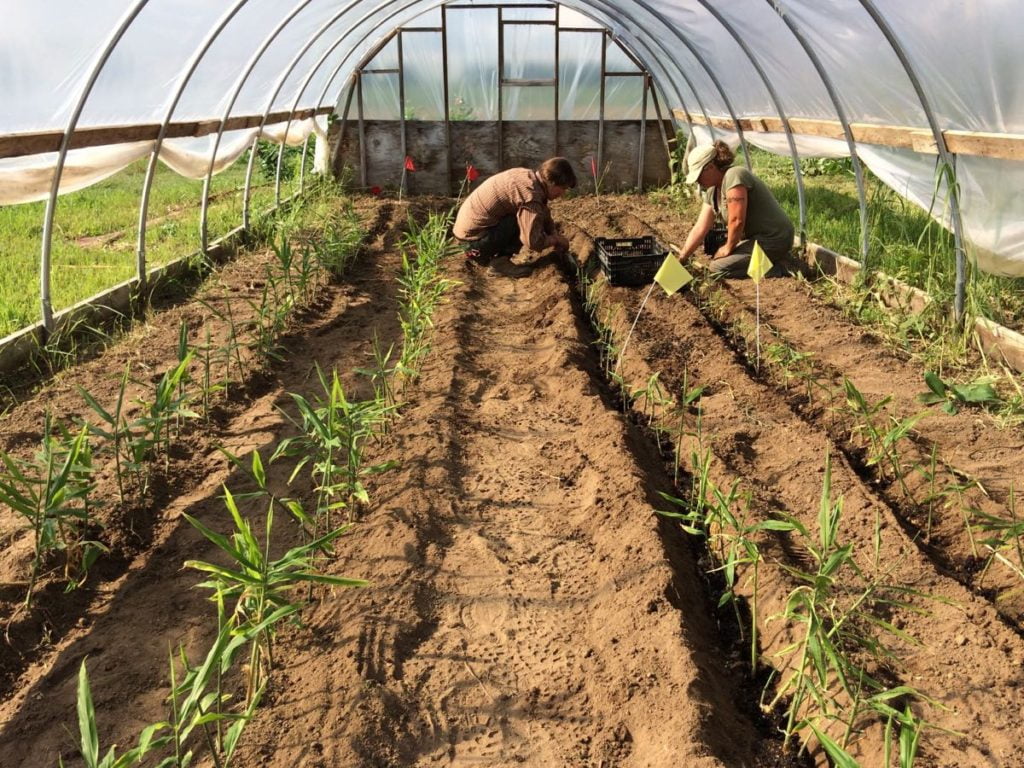
Here’s a job we can do when the fields are wet. Charlotte and Kristen transplant ginger into our smallest greenhouse. The ginger will also be ready to harvest in October. This little house is one of my favorite places on the farm. It’s small but tight enough to grow spinach for our family in winter.


For the most part, our crops love the heat and moisture. This is our sweet potato field, photographed three days apart. Three days!
What does ‘OR’ mean?
Often our Veggie List includes something like “globe eggplant OR cherry tomatoes, etc.” Sometimes our crops ripen in fits and starts, eg. eggplant and the first harvest of almost any crop. When there are small amounts, we split them up among the sites. We make sure that all boxes at a site are uniform. That lets us deliver cherry tomatoes in future to the people who received eggplant this week, and vice versa.
When our list says “xxx OR yyy” please do not open CSA boxes searching for your preference. All the boxes at your site are the same. Take your box off the top of the stack. When you open other members’ boxes, their produce warms up. No one wants that. Thank you for your help.
I will be away next week, leaving July 22.
I am taking our teenagers to visit family. Please limit communication with us until Sunday 7/30/17. Steve is staying home to take care of everything. If there’s an urgent issue, call or send an email and Steve will help you. However, he already has a lot on his plate. I will check in remotely when possible. Thank you! Beth
Veggie List and Veggie Notes
(Week #10; July 20/21, 2017; green EOW)
Caraflex cabbage
Swiss chard, 1 bunch
Carrots, 2 lb
Green bell &/or green frying peppers, ~4
Zucchini & summer squash, ~2 lb
Cucumber, 1
Walla Walla onion, 1 large
Flat parsley, 1 bunch
We have small amounts of several new crops, and your site might get one of these:
Broccoli OR cherry tomatoes OR globe eggplant OR a slicing tomato OR an extra cucumber.
Next week’s box will probably contain sweet corn, some kind of greens, carrots (unless it rains too much!), peppers, zucchini & summer squash, cucumbers, onion and more.
Carrots – The first carrot harvest! Refrigerate. We bagged these soon after washing (without much time to drain) so you might need to swap your carrots into a drier bag. Use your judgement.
Green peppers (sweet) – You’ll get green bell peppers (blocky) and/or a green frying pepper (long, slender). Both types are sweet. Frying peppers have lower moisture which makes them particularly suited to frying. Other than frying, the two types can be used interchangeably in recipes. A lot of the bell peppers this week happen to be small. They’ll reach a more typical size soon.
RECIPES
Visit our Recipe Log, a list of all our 2017 recipes. Check June 29 for other cabbage and Swiss chard recipes.
RECIPES FROM LOCAL THYME
Comforting Classics
Seared Cabbage Persillade
Provençal Chard and Zucchini Omelet
Zucchini Parmesan
Bean and Cabbage Soup a Le Marche
Outside the Box Recipes
Parsley Salad
Swiss Chard Carrot Juice
Chocolate and Zucchini Cake
Braised Cabbage with Prosciutto di Parma
Quick and Easy Meal
Laotian Charred Beef on a Bed of Cabbage
RECIPES FROM LAUREN
ALMOND-CRUSTED TROUT WITH RAINBOW CHARD & GRITS
Adapted from Bon Appetit
This recipe is adapted from a Bon Appetit favorite. The grits are tasty with any number of veggies thrown in. If you happen to have some garlic or jalapenos laying around, feel free to toss that in as well.
Now trust me when I tell you that the grits and chard are super simple to make. The only thing that makes this recipe tricky is the trout so I want you to know I am telling you right now, I won’t be offended if you skip the trout entirely. I also won’t be sad if you buy store bought ground almonds so you don’t have to grind them yourselves or if you skip the almonds altogether. It’s a fun recipe to make to completion if you have the extra 15 minutes to make the fish, but if you don’t, plain ol’ baked fish (any baked fish) will work just fine. Lauren.
Serves 4-6
Takes 50 minutes
2 tablespoons butter
1 bunch chard, ribs removed and sliced, leaves torn, divided
1/2 Walla Walla onion, diced
1 green pepper, bell or fryer will both work fine, diced
2 teaspoons Kosher salt, divided
3/4 teaspoon freshly ground black pepper, divided
1 cup grits (not instant) or cornmeal
2 cups water
2 cups whole milk (or substitute more water if you prefer)
1 cup whole, skin-on almonds (see note above)
1 large egg
1 pound trout filets, skin on (preferably rainbow trout from a fish market you trust)
2 tablespoons vegetable oil
1/2 teaspoon red pepper flakes
1/4 cup minced parsley
- Melt butter in a large sauce pan over medium heat. Add chard stems, onion and pepper along with 1-1/2 teaspoon salt and 1/2 teaspoon freshly ground black pepper. Reduce heat to medium low and saute for 10 minutes until very fragrant.
- Add grits, water and milk. Bring to a very gentle boil, reduce heat to medium low and gently simmer, whisking every couple minutes for 20-25 minutes until all liquid has been absorbed.
- Puree almonds in a food processor until texture of course breadcrumbs. Place in a shallow dish and season with 1/2 teaspoon Kosher salt and 1/4 teaspoon freshly ground black pepper.
- In a second shallow dish, whisk egg. Going filet by filet, dip skin side of filet into egg and then into almonds pressing down gently so almonds adhere. Place each filet on a plate (skin side up) and sprinkle with additional salt and pepper.
- In a large skillet, heat vegetable oil over high heat until hot but not smoking. Add filets, almond side down, to the pan (as many as fit without crowding (for me it was just one at a time). Press it down so things brown evenly. Cook for three minutes, flip and cook on the other side for an additional two minutes. Repeat with remaining filets, removing any burnt bits from the pan in between batches and adding oil as necessary.
- When fish are finished cooking but the pan is still hot (and has lingering pieces of almonds, oil and fish bits) toss in the torn chard. Sprinkle with a pinch of salt and 1/2 teaspoon of red pepper flakes. Saute for 2-3 minutes until wilted.
- Just before serving, stir parsley into the grits.
- Serve grits in a bowl with sauted chard and fish.
.
PICKLED CABBAGE SALAD
Borrowed from the incredible Smitten Kitchen
This is a Smitten Kitchen masterpiece just as simple to make as it is to eat. I’ve simplified it a bit but largely kept her original recipe. The marriage of cabbage, carrots and cucumbers is a match made in heaven. I’ve also had cabbage salads with red cabbage, cauliflower or pepper so feel free to toss any of these in the mix if you have them lying around.
As for how to eat this, it may be pickled (and perfect on top of some fried fish tacos) but this is no side dish. I love to just eat a big bowl of it for lunch. Light, bright and crunchy, it won’t way you down. It’s also great on the side of rich dishes or as a topping for grain bowls. The possibilities are endless for this yummy salad. Hope you enjoy! Lauren.
Makes 5-6 cups
Takes 20 minutes (mostly chopping) + at least one hour to rest in the pickling liquid
Brine:
1-1/2 cups white vinegar
1-1/2 cups water
1/3 cup sugar
1/2 teaspoon celery seed
2 tablespoons Kosher salt
Salad:
1 head Caraflex cabbage, cored and shredded
2-3 carrots, peel and thinly slice or julienne
1 cucumber, quartered and sliced
- Combine all brine ingredients in a large measuring cup or medium bowl. Whisk so sugar is well-combined. Whisk a few times if sugar and salt are not coming together.
- Add cabbage, carrots and cucumber to a large bowl. Pour brine over vegetables, toss to combine and cover bowl with plastic wrap. Store in the fridge for at least 1 hour (and up to 1 week). The longer it sits, the more pickled it becomes.
- Eat on its own or with everything!
.
Week #9, July 13 2017
- On: July 12, 2017
 0
0
Farm News

Steve has begun seeding our fall and winter storage carrots, and has already planted three acres. The seedlings are beginning to come up. The big question is whether any of these fields will need to be re-seeded after the rains. Carrot seedlings are delicate and have trouble emerging from the ground if there’s a crust. It’s pretty normal to have to re-seed at least one carrot field. I guess we don’t need the irrigation pipe this week!
It rained 4.5 inches this past week (2 inches on Monday night and 2.5 inches today). That’s not bad, considering the Madison area got 5 – 6 inches and a farmer-friend wrote that they got 10 inches. That’s crazy. We feel lucky. Our fields were getting dry, so the first 2 inches were welcome. The second round, not as much. Your produce is quite clean despite the mud; the crew gave it their full attention. Wash the beets carefully but that’s the only thing that will hold grit. A few items show storm damage. You can see dings in both the snap peas and basil but it’s cosmetic damage. Enjoy your produce and let’s hope for some drier weather. Beth
Let’s talk daikon radishes and Korean food
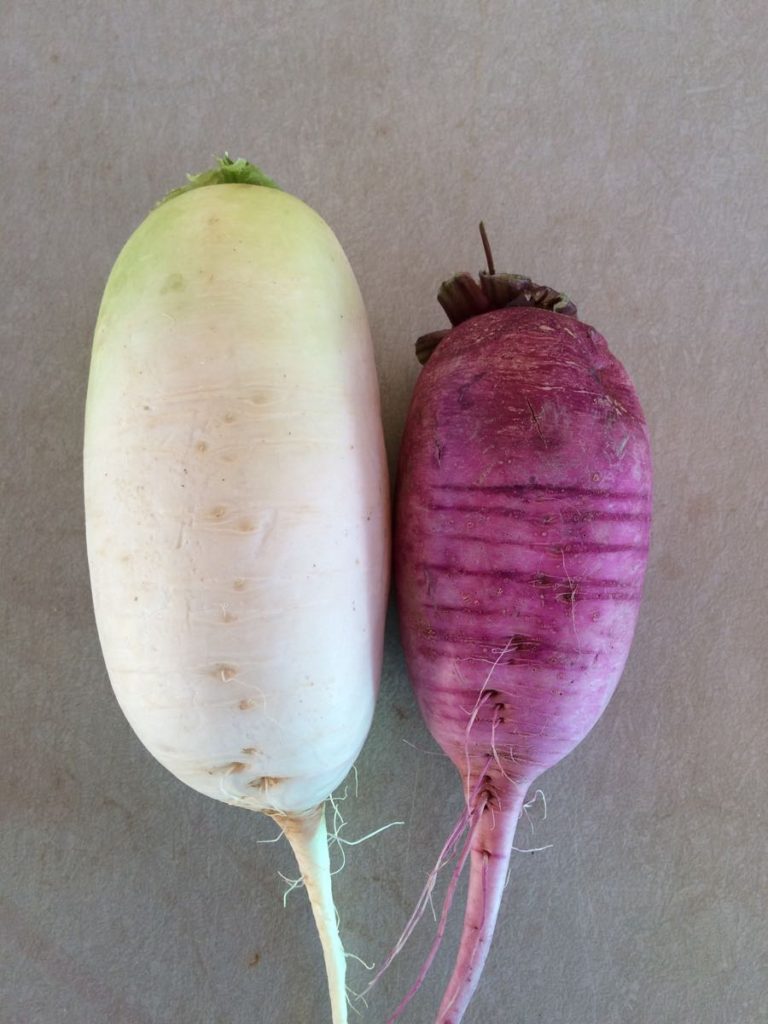
Everyone gets one purple and one white radish this week.
We are sending Korean daikon this week, the same type you received three weeks ago. I love Korean radishes! They are so much sweeter than the Japanese types. We might switch completely to the Korean types in future. First, we need to evaluate how they perform in fall plantings.
Uses: Daikon radish make excellent salads. Both Pat and Lauren gave us recipes for pickled daikon three week ago and both featured bahn mi recipes this week. Great minds think alike. The recipes have overlapping ingredients but each recipe is distinct. We are sending about 1 lb total this week, a perfect amount for salad although you may need to adjust the ingredient quantities since we sent more radishes three weeks ago. Here are their recipes.
– Summer Squash and Kale Tacos with Quick Pickled Radishes
– Pork, Broccoli & Snow Pea Lettuce Wraps with Pickled Daikon
– Grilled Pork Tenderloin Banh Mi Sandwich (A Local Thyme recipe this week)
– Bahn Mi Burgers (below)
I am enchanted with Korean cuisine. If you are interested in Korean food, you must check out Maangchi’s website. She has the best Korean recipes and videos, including an extensive list of daikon recipes. I enjoyed the Maangchi site this winter, making Tteokbokki (Hot and spicy rice cake), various stews, and Bibimbop (Rice mixed with vegetables, meat, an egg, and chili pepper paste), skipping half the ingredients but excellent with her White Radish Salad (Musaengchae).
I am eager to try her newest Cubed Radish Kimchi (Kkakdugi) recipe; I love kimchi and have always found homemade daikon kimchi recipes more reliable than those made with napa cabbage. When it comes to kimchi, I am an amateur compared to Maggie who makes gallons and gallons each year. I’ll get her to share one of her recipes in a future newsletter. If you don’t have Korean red pepper flakes, you can substitute paprika mixed with some cayenne, although the Korean pepper is ground more coarsely. Korean red pepper flakes have a lot of flavor but moderate heat.
In Madison, I shop for Korean staples at the Oriental Food Mart on Park Street, and at an Asian grocery at the northwest corner of Odana and Whitney Way. Lee’s Oriental on University is good too. The owners at Oriental Food Mart on Park Street are very helpful. If you have questions, that’s the place to go. Beth

Ari, Steve and Sophie enjoy a New Years Eve feast at Koreana restaurant outside Toledo. At least five dishes on the table contain daikon. We try to stop at this excellent restaurant during our annual cross-country trip to celebrate Christmas and Hanukkah with family. This year, we managed to stop on both legs of the journey!
Veggie List and Veggie Notes
(July 13/14, 2017; week #9, purple EOW, sun Sampler)
Beets with greens, 1 big bunch
Sugar snap peas, 1.7 lb
Cucumbers, 2
Broccoli, 1 or 2 nice heads
Zucchini & summer squash, 2 – 3 lb
Korean daikon radishes, ~2, white or purple
Walla Walla onion, 1
Basil, 1 bunch
Fresh garlic, 1 bulb
Next week’s box will probably contain ‘Caraflex’ cabbage, cucumbers, zucchini, Walla Walla onion, carrots (unless it rains too much) and more.
Beets with greens – Beet greens are tasty. They are similar to Swiss chard in flavor (the two crops are very closely related.) This week’s greens are a little tough so you should remove the thickest midribs before cooking, and give them a little extra cooking time. We could have harvested them last week but the fennel harvest was more urgent. The extra week gave the beet roots more time to plump up.
Storage: Cover and refrigerate. Separate the tops and roots if you don’t plan to eat the greens immediately, to preserve freshness in the roots. Beet greens are perishable and should be eaten soon. The beet roots will last for weeks.
Sugar snap peas – Let’s give a big cheer for our crew who persevered with the lengthy pea harvest. This might be the largest bag of snap peas we’ve ever put in the CSA boxes. These peas are showing some light storm damage. You’ll see white spots from rain or hail. The peas are not as perfectly tender as those we delivered last week but are still sweet and delicious, good for either raw salads or lightly cooked.
Cucumbers – The first cukes! Enjoy!
Korean daikon radishes – See above.
Fresh garlic – This is the first garlic harvest. We can ship these while freshly dug, without curing. We’ll complete the garlic harvest soon, but then the bulbs need to cure. It will be a few weeks until we can send more. Good thing we have lots of onions.
RECIPES
Visit our Recipe Log, a list of all our 2017 recipes. We’ve already accumulated several zucchini recipes over the past two weeks.
LOCAL THYME RECIPES
Comforting Classics
Grilled Pork Tenderloin or Tofu Banh Mi Sandwich
Beets, Beet Greens, and Sautéed Onions with Feta and Pine Nuts
Raw Beet Salad
Wagon Wheel Pasta with Peas
Outside the Box Recipes
Hoisin Braised Daikon
Bruschetta with Beets and Goat Cheese
Broccoli Pesto
Chilled Snap Pea Soup with Honey Sage Butter
Quick and Easy Meal
Seared Scallops on Snap Pea Puree
RECIPES FROM LAUREN
BAHN MI BURGERS
I know it looks like a long ingredient list on this one but I promise it will come together in a cinch. The hardest thing you have to do is cut daikon into matchsticks and pickle them. Also note that a technically traditional bahn mi uses a Vietnamese baguette, some sort of delicious slow-roasted pork product (usually pork belly), pork pate, pickled daikon & carrots, cucumber slices, pickled jalapeno, and cilantro so calling this a bahn mi is a bit of a stretch. But it’s darn tasty so we’re going there anywhere. Lauren
Makes 6-8 burgers
Takes 1 hour
Pickled Daikon
1/2 cup rice wine vinegar
1/2 cup water
1/2 cup sugar
1 tablespoon soy sauce or tamari
3 cups daikon, white or purple or a mix, cut into matchsticks (no need to peel)
Burgers:
2 pounds ground pork
6 cloves garlic, minced
1 teaspoon curry powder
1 teaspoon fresh lime juice
Kosher salt and freshly ground black pepper
Spicy Mayo:
1 cup mayonnaise
4-6 tablespoons sriracha depending on your preference for heat
1 tablespoon fresh lime juice
1 tablespoon sugar
1 tablespoon soy sauce or tamari
For Assembly:
6-8 of your favorite burger buns (or baguette bread sliced into bun size for a more authentic bahn mi), toasted
Cucumber, very thinly sliced
Basil
Pickled sliced jalapeno, optional
- Make pickled daikon. Combine rice wine vinegar, water, sugar and soy sauce together in a large bowl. Whisk to combine. Add daikon and leave at room temperature to rest while you prepare the rest of the burger. Let pickle for at least thirty minutes. Feel free to do this step the morning or night before preparing the burgers.
- Make your burgers. Combine pork, garlic, and curry powder in a large bowl along with a generous amount of salt and pepper. Form into 6-8 patties depending on the number of mouths you are feeding. Grill the burgers or cook them in a small amount of vegetable oil on the stovetop until cooked through or about 3-4 minutes per side. Remove to a plate and let rest for 5 minutes.
- Prepare spicy mayo. Combine all ingredients in a small bowl and whisk to combine until smooth. Taste and adjust seasonings to your preference.
- Assemble burgers. Spread a generous about of spicy mayo on the base of your toasted buns. Top with a 6-10 slices of cucumber followed by burger patty. Add a few basil leaves, some pickled jalapenos (if using) and a generous pile of pickled daikon followed by the top of your bun. Press down slightly to try and make your burger a manageable, bite-able size and enjoy!
BEET, SNAP PEA & AVOCADO SALAD
Adapted from Yotam Ottolenghi’s Plenty
Takes 30 minutes
Serves 2 as a main dish dinner salad or 4-6 as a side
1 bunch beets
3 tablespoons sherry vinegar (red wine or balsamic vinegars also would work fine)
1/4 cup olive oil
1/2 tablespoon hot sauce
1 teaspoon kosher salt
1/2 teaspoon sugar
1 Walla Walla onion, thinly sliced
3 cups snap peas, ends trimmed and halved lengthwise
1 avocado, thinly sliced
1/4 cup basil leaves
- Bring a large pot of unsalted water to a boil on the stove. Prepare beets, by trimming off the tops. Discard the greens or save for another purpose. Cut any beets larger than a golf ball in half. If they are the size of a baseball, cut them into quarters. Drop the beets into the boiling water and blanche for 5 minutes. Strain and rinse under cold water until cool enough to peel. Peel beets. Thinly slice beets (ideally on a mandolin if you have one but a knife will work fine if you don’t).
Whisk together vinegar, olive oil, hot sauce, salt and sugar in a medium bowl. Add sliced onion and beets. Let sit for 15 minutes. - Meanwhile, prepare peas. Trim ends and slice in half lengthwise. Mix together peas and basil leaves on a large, lipped platter. Lay avocado over the top. Once onions and beets are ready, pour them over the peas, mint and avocado. Use as much of the dressing as you desire.
.
Week #8, July 6 2017
- On: July 05, 2017
 2
2
I queried our crew members about their favorite fruits and vegetables that we grow. Here are some of their responses plus a photo for each. I’ll post more people’s responses in a future newsletter. Think of our hard-working crew when you enjoy one of their favorites! Beth
Smitty Bietila (2008 – 2013, returned in 2017) Kale, the gift that keeps on giving all summer long.
Jory Carlin (2014) Carrots because they are delicious.
Jon Fagan (2013) Crenshaw melons. Jon loves crenshaw melons because they are delicate, ephemeral, sweet and delicious. They are very difficult to grow in Wisconsin so we only get a few each year.
Billy Frain (2013) Onions. He likes the steps in harvesting onions; pull from the ground, leave to dry, pull off tops, gather to cure in the greenhouse. Also … “Carrots. They bring the whole crew together during weeding, despite the tedious, arduous nature of the work.”
Charlotte Hammond (2016) “Watermelons because our watermelons are the best on the planet. I can eat a whole watermelon every day during melon season. If I ever have my own farm, it’s gonna be a watermelon farm.” It’s also her favorite crop to harvest. Charlotte is on Steve’s melon harvest crew because she’s very strong and can catch. Out of season, Charlotte stays in shape with a ‘watermelon chair’ exercise routine, using a Roman chair at her gym (google it for photos). She works with 20+ lb weights to mimic picking up and stacking melons.
Kristin Knoener (2008, returned in 2016) Kristin likes cherry tomatoes, lettuce and watermelons. “There’s nothing like watermelon at 3:00 pm on a hot day.”
Kelcie Morgan (2015) Sweet corn. “It’s a fast-paced straight-forward harvest, a race to the end of the row. Then we get to eat it on the wagon on the way back to the buildings.” Strawberries and peas are other favorites to eat but are not her favorites to harvest. (Beth’s note; these low-to-the-ground crops are hard on everyone’s backs.)
Maggie Schley (1999?) Maggie loves cucumbers because she loves pickles and salt and fermentation. Tipi carrots are a big part of Maggie’s life. They were pictured on her wedding invitation. She has lots of carrot jewelry. Everyone on the farm saves ‘lover carrots’ for Maggie; carrots that have grown together in a spiral. Maggie is always on the carrot harvest crew.
Dana Teske (2015) Sweet corn. It’s her favorite to harvest and favorite to eat.
Jim Walker (2016) Rhubarb. He likes the fact that you can make dessert from a vegetable with mildly poisonous leaves. (Actually, it’s a petiole.) Also, it reminds him of home because rhubarb grew at all the houses where he grew up.

Jory (center) helped re-insulate and re-cover our cooler roofs last year.

Billy shows off some ‘farm bling’ he unearthed in a field. We find all kinds of things.
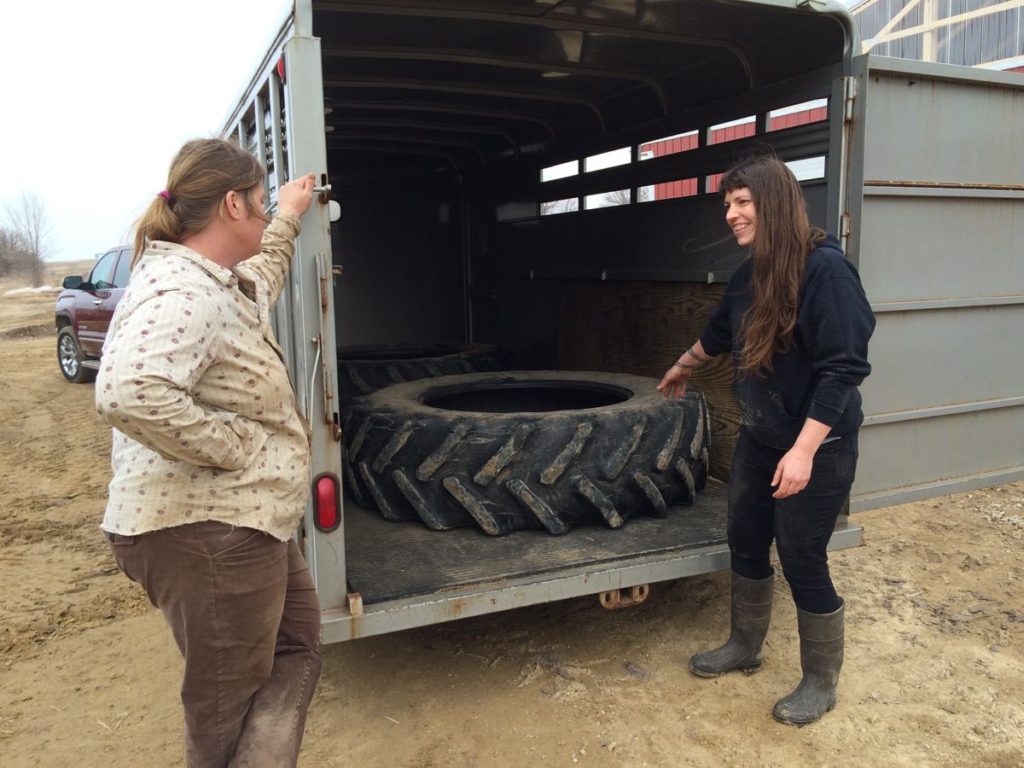
From left, Maggie and Charlotte retrieve an old tractor tire from the farm. It weighs 284 lbs. They took it to Charlotte’s farm for strength training, where they train by flipping the tire. These are two strong women.

Kristin in an untilled area of our farm. I want to establish prairie plantings and Kristin is helping me figure out how to do it. She’s worked in prairie restoration for years and has deep knowledge about prairie management.
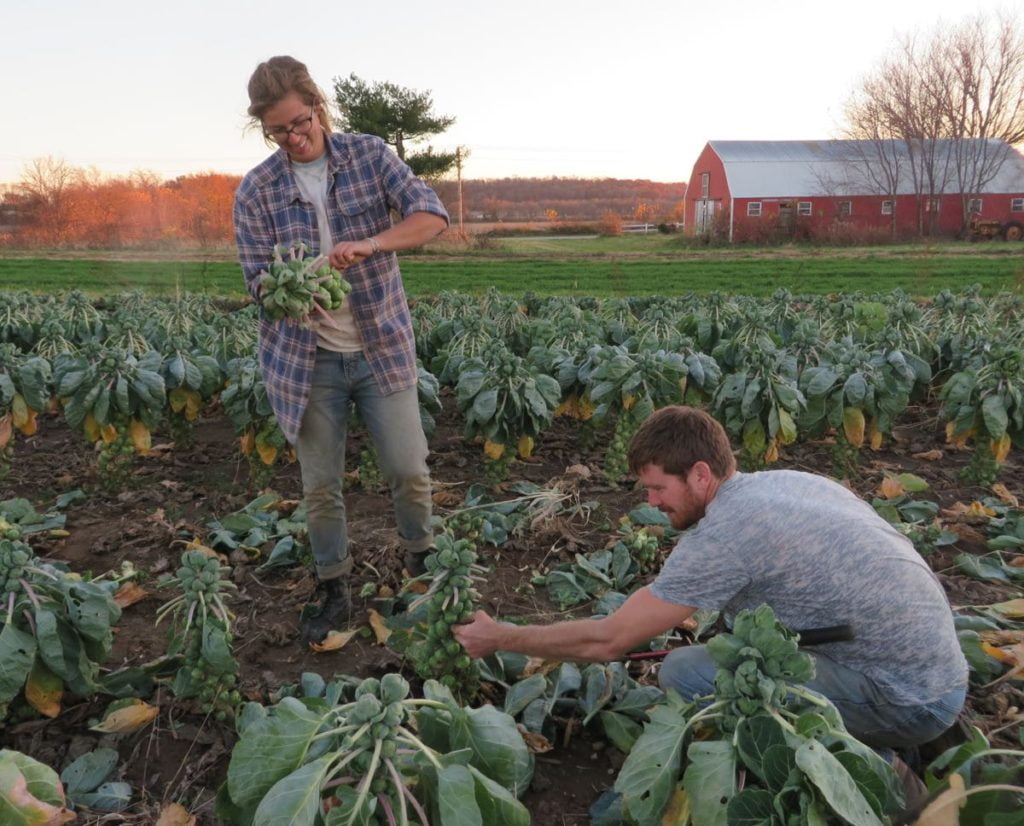
Kelcie and Billy harvest Brussels sprouts two falls ago.
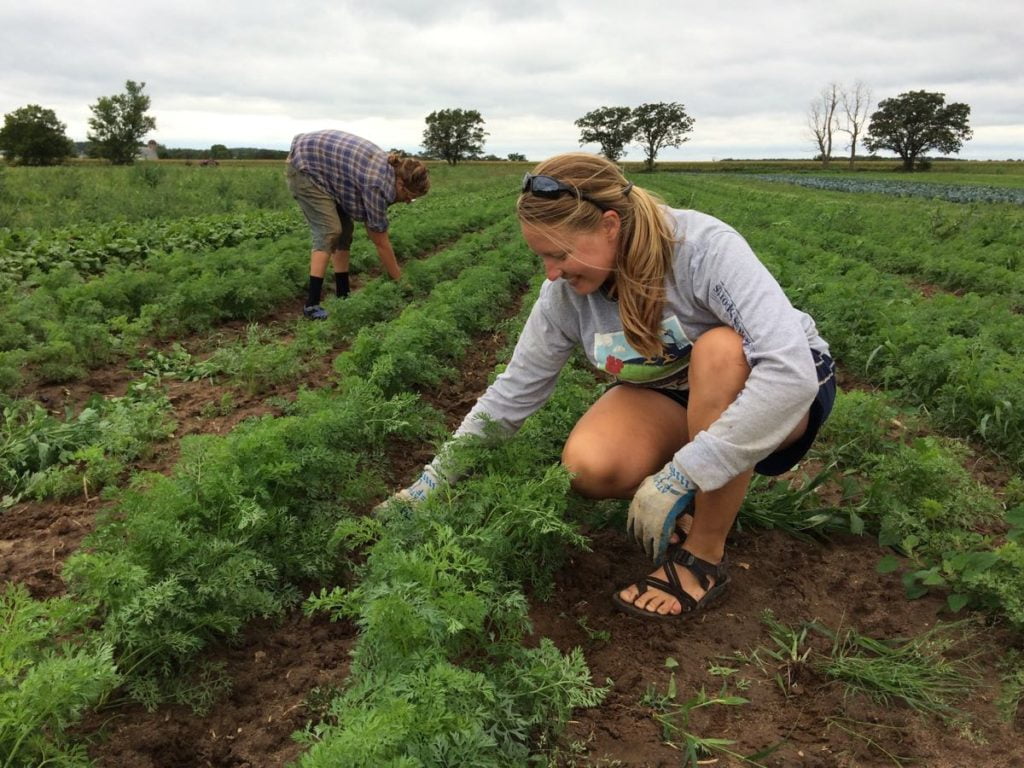
From left, Kelcie and Dana weed carrots.
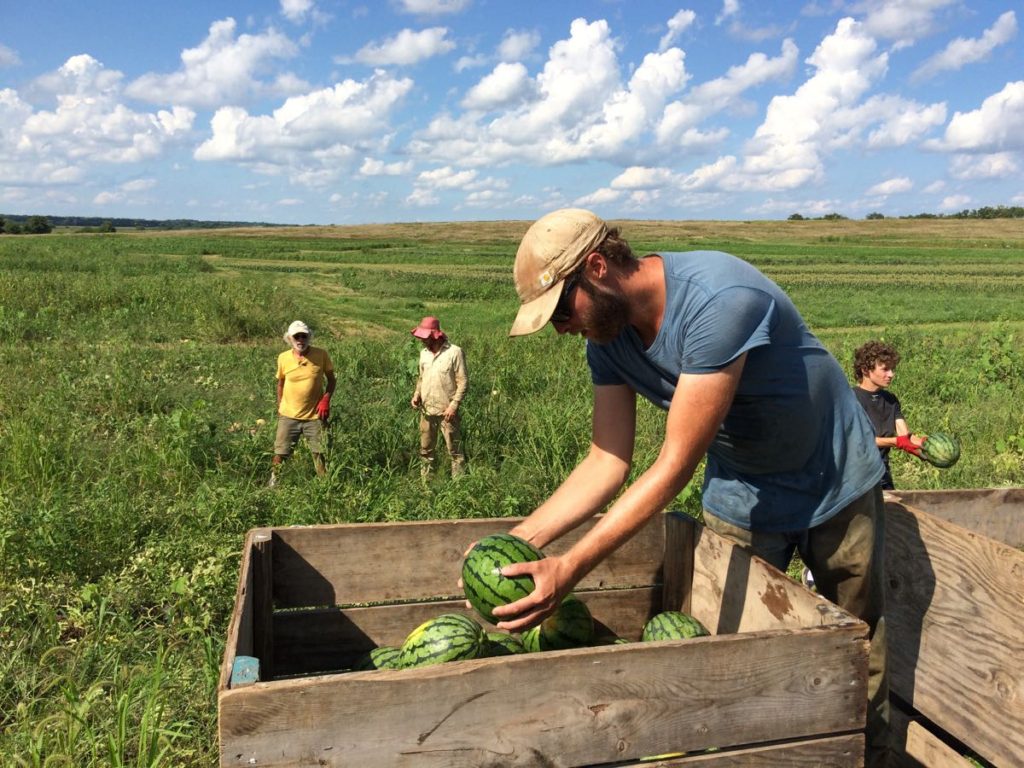
Jim stacks watermelons at harvest.
Veggie List and Veggie Notes
(July 6/7, 2017, green EOW)
Fennel, 1 bulb with fronds
Broccoli, 1 – 2 nice heads
Snap peas, 1.3 lb
Zucchini & summer squash, ~3 lb
‘Salanova’ lettuce (red or green)
Kohlrabi, 1 (or 2)
Sweet Walla Walla onion, 1 large
Basil, 1 husky sprig
Next week’s box will probably contain some type of greens, carrots, Walla Walla onion, zucchini, basil, fresh garlic and more.
Fennel (large vegetable with a fat bulb and lacy fronds) – Fennel is a ‘swing vegetable’; it can be used raw or cooked. Clean well and slice as thinly as possible for use in raw salads. It is good simply prepared with olive oil, lime or lemon juice, salt and shaved parmesan cheese. Cooking softens and sweetens fennel, and mellows its anise flavor. Both the bulb and leaves are edible. Here are ideas from Alice Water of Chez Panisse about how to use fennel: ‘It’s strong anise characteristic seems to suit fish particularly well. … We use fennel all the time. We add the feathery leaves to marinades for fish and to numerous salads, sauces and soups and we use them as a garnish, too. … The bulbs are sliced and served raw in salads in various combinations with other vegetables, parboiled for pastas; caramelized and served as a side dish; braised whole; or cooked in vegetable broths & fish stocks.”
Snap peas – We harvested two varieties this week. One has strings, the other is stringless. You’ll just have to figure out which one(s) you receive.
Kohlrabi (round, pale green) – See our June 15 newsletter for info on kohlrabi.
Walla Walla onion – Yeah for the first Walla Wallas! These are sweet onions, crisp and very mild. Wonderful raw or lightly cooked. Try cutting into wedges, threading on a skewer and grilling. Do not try to fry these onions – it doesn’t work because of their high water content. Storage: It’s OK to store at room temperature for up to one week. Otherwise, refrigerate.
Basil (curly-leaved sprig) – Almost everyone receives the ‘Napoletano’ variety this week. The leaves are larger and more frilly than most basils. We like this variety because it remains tender and flavorful even as the plants mature. Storage: Basil will blacken if stored in the refrigerator. It is best stored at room temperature with the cut ends in water, for example in a jar or vase. Treat it like a flower. Give the stem a fresh trim. You will receive one sturdy sprig this week.
‘Salanova’ lettuce – This is a new innovation in lettuce breeding that lets you prepare salad mix easily. It also has nice flavor and texture, even during the summer when it’s otherwise difficult to grow lettuce. Cut the head across the base and it will fall apart into individual leaves. Dunk and swish in a tub of water. Drain and spin dry to store.
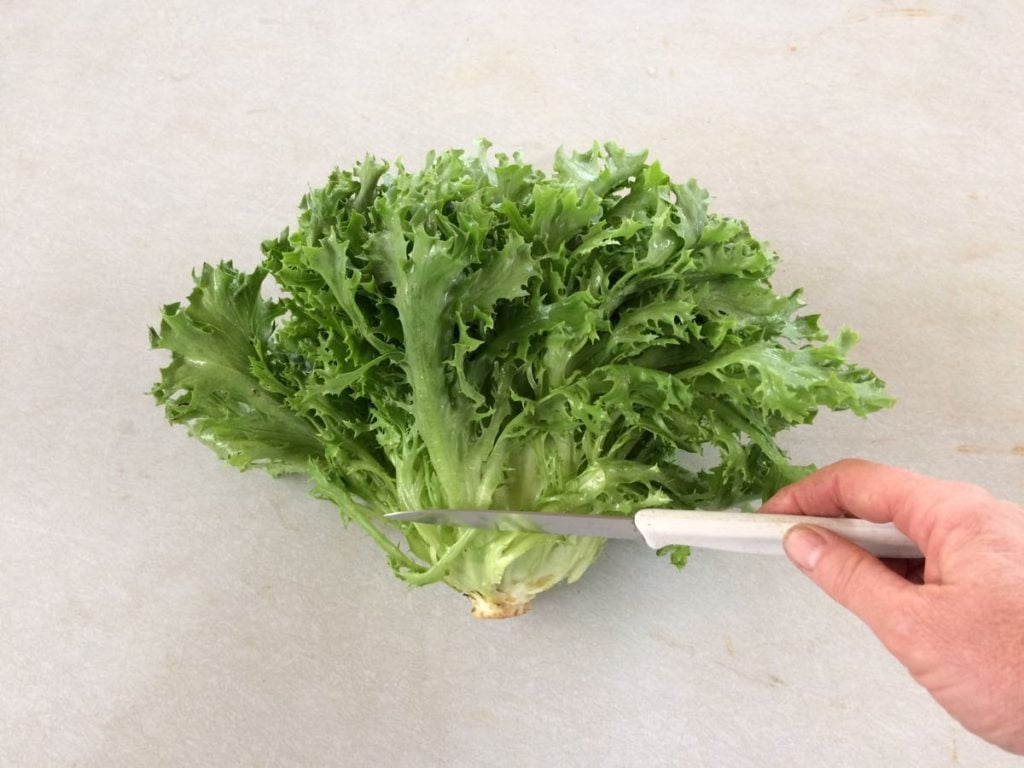
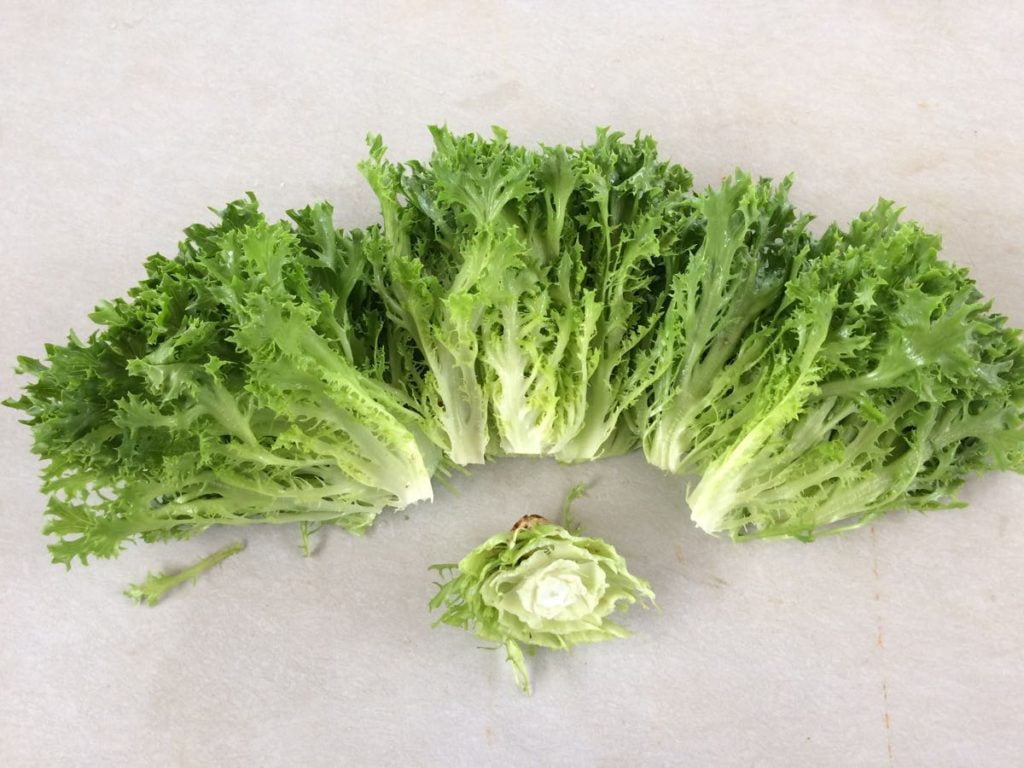
We’re pleased with the new ‘Salanova’ lettuce variety. Cut the lettuce head at the base and it falls apart into salad mix. Isn’t that great?! You’ll get either red Salanova or green Salanova this week.
RECIPES
Visit our Recipe Log, a list of all our 2017 recipes. We’ve already accumulated several zucchini recipes over the past two weeks.
LOCAL THYME RECIPES
Comforting Classics
Chopped Salad of Kohlrabi, Snap Peas, Chicken (other options listed) and Sweet Basil Dressing
Barefoot Contessa’s Roasted Broccoli with Pine Nuts, Lemon and Parmesan
San Franciscan Cioppino
Sweet Onion Rings with Basil Buttermilk Dip
Outside the Box Recipes
Snap Peas with Japanese Seasoning
Pasta Salad with Broccoli, Zucchini, Basil, Feta and a Medley of Olives
Roasted Chicken and Fennel with Oranges and Olives
Curried Squash Soup
Quick and Easy Meal
Kohlrabi and Lamb Stew
RECIPE FROM LAUREN
Summer Pad Thai
Pad thai is a quick easy meal, but it does require quite a bit of slicing and dicing. Get all your vegetables prepped before you start as things will move very quickly once you begin cooking. Lauren.
Takes 45 minutes
Serves 4-6
8 ounces rice noodles (Thai Kitchen is in most every grocery store and has great Pad Thai noodles)
1/4 cup peanut oil or other mild oil (vegetable or olive oil would both work fine), divided
1/4 cup tamarind paste (if you can find it, I never seem to have any on hand so I substitute 2 tablespoons lime juice with 2 tablespoons brown sugar or raw sugar)
1/4 cup fish sauce
1/3 cup honey
2 tablespoons rice wine vinegar
1 tablespoons soy sauce or tamari
1-2 teaspoons red pepper flakes
1/2 Walla Walla onion, diced
3 garlic scapes (if you have some leftover, skip it if you don’t)
2 eggs
1 head broccoli, finely chopped
2 pounds zucchini and summer squash, cut into matchsticks
1/2 cup chopped peanuts plus more for garnish
1/2 pound snap peas, end removed and thinly sliced, for garnish
Basil, thinly sliced, for garnish
Limes, quartered
- Place noodles in a large bowl.
- In a large stock pot bring enough water to cover the noodles to a boil. Pour over noodles and let stand for 7 minutes. Drain noodles, return to bowl and toss with 1 tablespoon peanut oil.
- Meanwhile, in a small sauce pan combine tamarind paste (or substitutions), fish sauce, honey, rice wine vinegar, soy sauce and red pepper flakes. Whisk to combine and then heat over medium heat until sugar and honey dissolve. Remove from heat.
- In a large skillet, heat remaining oil over medium heat. Add onion and garlic if using. Saute for 3-5 minutes until fragrant and soft. Add eggs and scramble gently. Once eggs are most cooked add the broccoli. Continue sauteing and cooking the eggs for 5 minutes until broccoli is bright green.
- Add noodles, zucchini, summer squash and sauce. Stir to combine then cook for 2 minutes until everything is warm and zucchini is just barely cooked. Stir in 1/2 cup peanuts just before serving.
- Serve warm with peanuts, snap peas, basil and lime wedges.
.
Fennel & Kohlrabi Salad
Borrowed from my dear friend Andrea Bemis of Dishing Up the Dirt
I always thought I couldn’t eat fennel raw until I shaved it real thin and paired it with some apple and a light homemade vinaigrette. Something about this simple salad transformed the way I looked at fennel. Now I love to eat raw fennel as a side to something real rich and hearty (like a grilled steak or porkchop). This recipe takes things a bit further pairing fennel with crunchy kohlrabi and onion alongside some walnuts and blue cheese. Together it makes for a powerhouse dish. PS Feel free to sub feta for blue cheese if you are a real blue cheese hater. It won’t make much of a difference. Lauren.
Takes 20 minutes
Serves 4
1/4 cup apple cider vinegar
3 tablespoons honey
1-1/2 teaspoons Dijon mustard
1/2 teaspoon celery seeds
1/2 teaspoon Kosher salt
1/2 teaspoon freshly ground black pepper
3-1/3 tablespoons extra virgin olive oil
1 large or 2 smaller kohlrabis, stems and greens discarded, peeled and cut into matchsticks
1 large fennel bulb, stems removed (and saved for another use), halved, cored and very thinly sliced (if you have a mandoline- use it!), plus a few fronds for serving
1/2 Walla Walla onion, very thinly sliced
1 apple (honey crisp or granny smith work best in my opinion), sliced into thin matchsticks
1/4 cup walnuts, roughly chopped and toasted
1/4 cup good quality blue cheese, crumbled
- In a large bowl wisk together the vinegar, honey, mustard, celery seeds, salt and pepper. Slowly whisk in the oil until well combined.
- Add all the thinly sliced vegetables (and fruit!) to the bowl and toss well to combine.
- Divide between plates and top with toasted walnuts, crumbled blue cheese and a few fennel fronts. Season to taste with additional salt and pepper if need be.
.
Week #7, June 29 2017
- On: June 29, 2017
 0
0

Steve sunk a tractor in the ground on Monday. Before plowing a wet bottom field, he attempted to set the plow to a shallower depth but accidentally set it deeper. He plowed a furrow that was too deep and got stuck. Steve came moping back to the house, worried that we would need help extracting the embedded tractor and plow. That’s expensive (if we hire a rig) or embarrassing (if we ask a neighbor for help). It’s difficult and risky when the tractor and implement are still hitched together. He didn’t sleep well at all that night. By morning, Steve and Roger had a plan that worked, using other tractors and a front-end loader. All was well but it was an unsettling moment for Steve. Beth
Veggie List and Veggie Notes
(June 29/30, 2017; week #7, purple EOW, moon Sampler)
Beth’s Box Logic: We planned this delivery with your July 4th celebrations in mind. You’ve got ingredients for …
– cole slaw (cabbage, scallions),
– cold salads (Romaine, peas, parsley),
– grilling (zucchini),
– pasta salad, our go-to meal for picnics (grilled zucchini, peas, Swiss chard, scallions, parsley) and
– cocktails (tomato juice)
You will find something festive to prepare. Have a great 4th of July!
Box Contents
Tipi tomato juice, 1 quart
‘Caraflex’ cabbage
Sugar snap peas, ~1.2 lb
Swiss chard, 1 big bunch
Zucchini & yellow summer squash, ~3 lb
Romaine lettuce
Scallions, 1 bunch
Curly parsley, 1 bunch
Next week’s box will probably contain sugar snap peas, beets with greens, zucchini, broccoli, sweet Walla Walla onion, basil and more.
‘Caraflex’ cabbage – This is a nice salad-type that we grow in summer. Don’t you love the pointy shape? It has thinner, more tender leaves than the usual green cabbage. Great in salads and slaws but can also be cooked. Here’s the description from the seed catalogue: “Inner leaves are tender, crunchy, and have an excellent, sweet and mild cabbage flavor. Perfect for summer salads, slaws, or cooked dishes.”
Swiss chard (pretty bundle of green leaves) – Our crew did a nice job mixing colors for pretty bunches. Swiss chard is a close relative of spinach, but requires a bit more cooking. Use as a substitute in any recipe that calls for spinach, just cook the chard a little longer. Both stems and leaves are delicious. The stems requite longer cooking, so cut them free from the leaves when preparing. That allows you to cook the stems longer.
Parsley – This is the most versatile, widely-used herb that we grow. This week, I plan to make a tabouleh-style salad with snap peas, grilled zucchini, scallions and lots of parsley.
Tipi tomato juice – We had this juice bottled from our tomatoes last summer. It’s a great way to capture ripe tomatoes at peak season, at a moment when we are swimming in tomatoes. Drink it or try making an easy soup. Simmer diced zucchini and Swiss chard in the juice. Add minced scallions and parsley near the end of cooking. Voila! Soup!
Storage: Store the juice out of sunlight at room temperature when unopened. Refrigerate after opening. The juice is already seasoned so do not add salt if you cook with it.
Ingredients: organic tomatoes from Tipi Produce, salt, organic garlic, organic onion, organic black pepper. I’ve posted the nutritional information here.
LOCAL THYME RECIPES
Comforting Classics
Greek Swiss Chard and Zucchini Soup
Pan Fried Tofu on Cabbage and Snap Pea Salad
Zucchini Scallion Fritters
Classic Coleslaw
Outside the Box Recipes
Zucchini and Swiss Chard Tart
Vietnamese Snap Pea Stir Fry
Orzo Salad with Grilled Summer Squash
Swedish Cabbage Soup
Quick and Easy Meal
Turkey, Bacon and Parsley Pesto Mayo Sandwich with Romaine
RECIPES FROM LAUREN
GRILLED CABBAGE, SNAP PEA & SCALLION SALAD
There’s little I enjoy more than bringing home a huge tote of vegetables and tossing them on the grill for a simple but amazing dinner. This week’s creation involves grilling a lot of things not commonly thought of as grillable but you’ll have to trust me that grilled cabbage and snap peas are a real thing of beauty. If you don’t have a grill or equipment good enough to keep veggies from falling through the grates you could broil your vegetables on a sheet pan for 15-20 minutes until very well charred in places. That was my go to “grilling” technique before we purchased an awesome grill last summer. And still my technique when summer storms keep me inside. Lauren.
Takes 30 minutes
Serves 4-6 as a side to some hearty cut of meat also done on the grill or 2 as a main dish
1/4 cup olive oil, divided
1 cabbage, cut it half lengthwise and cut in half
1 pound snap peas (or as many as you can spare), ends trimmed
1 bunch scallions, ends trimmed
Kosher salt and pepper
2 tablespoons rice wine vinegar
1 tablespoon toasted sesame oil
2 tablespoons brown sugar
1 tablespoon tamari or soy sauce
1 teaspoon fish sauce
1/2 teaspoon red pepper flakes
2 tablespoons toasted sesame seeds
- Drizzle one tablespoon of olive oil on a baking sheet. Add cabbage, snap peas and scallions. Drizzle with additional tablespoon of olive oil and then sprinkle generously with salt and pepper. Toss gently with your hands to coat veggies evenly with oil.
- Get your grill ready. The hotter the better. Grill veggies directly over heat (one of these fancy grill pans or baskets that keeps the veggies from falling through might be helpful) flipping so both sides get blackened in spots. This takes about 5-6 minutes for the scallions and peas and closer to 10 minutes for the cabbage. A little char is a great thing, especially for the cabbage. If you are broiling, just keep them on the baking sheet and put them RIGHT under the broiler for 20 minutes, flipping the veggies after 10 minutes.
- Remove veggies, allow to cool briefly. Add peas to a medium bowl. Slice cabbage and scallions thinly (as best you can) and add to the same bowl.
- Whisk rice wine vinegar, remaining olive oil, sesame oil, brown sugar, tamari, fish sauce and red pepper flakes together in a small bowl. Pour dressing over veggies. Add sesame seeds and stir to combine. Serve warm or cold.
.
ZUCCHINI & SWISS CHARD TART
Recipe adapted from New York Times
I make pie crust in my food processor following Smitten Kitchen’s basic guidelines for “all butter, really flaky pie dough” every single time I need a pie crust regardless of what the recipe calls for and I am NEVER disappointed. It’s simple, quick and incredibly flaky. Do note that this makes a double batch (aka two pie crusts) so either make half the Smitten Kitchen portion (which is a little more difficult in your food processor) or two tarts! Lauren.
Makes 1 tart
Serves 4-6
Takes 1 hour, 45 minutes (much of it inactive), a little longer if you make the dough from scratch
1 store-bought pie crust or follow instructions for my favorite pie crust (see note above)
2 tablespoons olive oil
2-3 scallions, white and pale green parts, diced
1 teaspoon Kosher salt, divided
1/2 teaspoon freshly ground black pepper, divided
1 bunch Swiss chard, stems removed and diced, leaves roughly chopped
2 pounds zucchini and/or summer squash, diced
1/4 cup minced curly parsley
3 eggs, beaten
3/4 cup Gruyere (or Swiss if you can’t find that) cheese
- If making pie crust from scratch, do this first so it has time to chill in the fridge for 20 minutes.
- Preheat the oven to 375 degrees.
- In a large saute pan, add olive oil, scallions and chard stems. Season with 1/2 teaspoon salt and 1/4 teaspoon pepper. Cook over medium heat for five minutes until fragrant. Add zucchini and chard leaves, stir often for 10 minutes. Zucchini should be tender but still bright green and greens should be wilted. Add parsley, cook about 1 minute longer just to combine flavors. Remove from heat and set aside.
- Beat the eggs in a large bowl. Stir in remaining salt and pepper. Add zucchini chard mixture and cheese. Mix everything together and then add remaining pepper.
- If making your own pie crust, roll it out into a circle and line a 9 or 9.5-inch pie pan. †If not, just grab your store-bought crust. Fill pie crust with zucchini chard mixture. Bake for 50 minutes or until center is set and top is golden brown. Allow to set for 15 minutes before serving. It’s fine to serve this warm or at room temperature.
U-pick re-cap
- On: June 21, 2017
 0
0
I cannot tell you how much how much Steve and I enjoy the u-picks, mostly because you folks enjoy them so much. Ripe strawberries straight from the plant are spectacular. Most fruit sold in the grocery store is mediocre by comparison. The weather on Saturday was unexpectedly perfect and mild; warm with a gentle breeze and some cloud cover. It was a picture perfect day. Beth

Steve, Ari and Billy staffed the berry field, showing people where and how to pick. You can see Billy at right in an orange shirt, running to greet the next group of members.


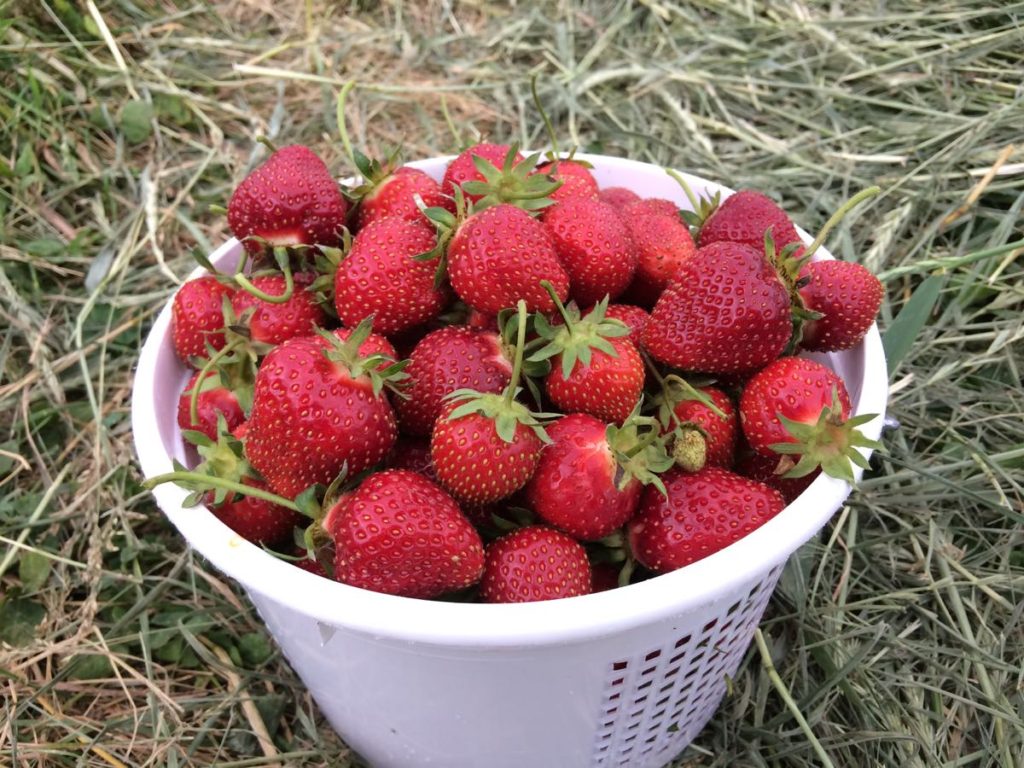
Happy berry pickers. Almost everyone picked more than they planned because the berries were abundant.

This young lady wore her special strawberry sunglasses!

Everyone got to see our new pack shed when it was time to weigh their berries.
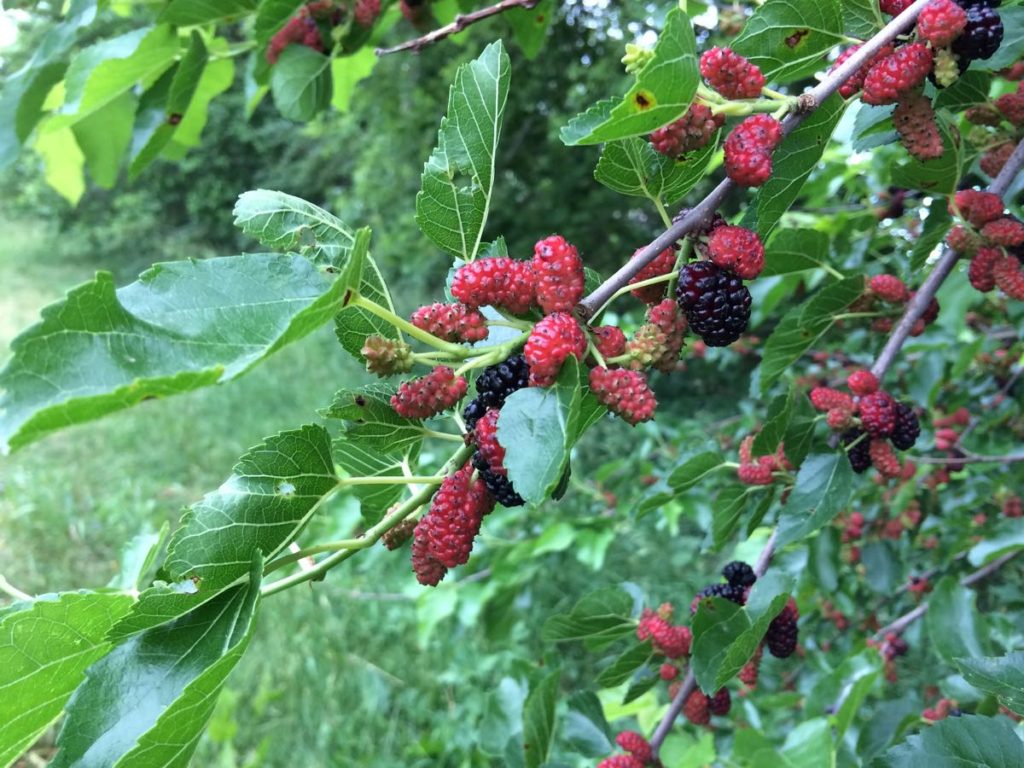
The mulberries are just beginning to ripen.


Mulberry pickings and a special one to share with Billy.
Veggie List and Veggie Notes, June 22/23, 2017, week #6, green EOW
Strawberries, 1 qt
Snow peas &/or snap peas, 1.1 lb
(In same bag, snap peas on bottom, snow peas on top.)
Zucchini &/or summer squash ~3 lb
Broccoli, 2/3 – 3/4 lb
Red bibb lettuce
Kale, 1 bunch
(Some sites get lacinto, some get Red Russian.)
Daikon, white
Daikon, purple
(2 – 4 daikon total; 1.5 – 2 lb)
Greek oregano, 1 bunch
Garlic scapes, a handful
Next week’s box will probably contain ‘Caraflex’ cabbage, snow peas, zucchini, Swiss chard, scallions and more.
Strawberries – These are ripe. Eat soon.
Snap peas and snow peas. These will be together in one bag.
– Snap peas (plump pea pods) – These peas should be eaten pod and all. They are delicious raw, or very lightly cooked or stir-fried. Preparation: They will need a quick rinse to remove faded gray blossoms. This is a new stringless variety, so there is no need to remove any strings. Remove the stem and they are ready to eat. Storage: Refrigerate.
– Snow peas (flat pea pods) – These are excellent stir fried or in raw salads. Preparation: Snow peas have strings. Here’s how to remove them. Snap off the stem end and pull the string down the concave side of the pod (the inward-curing side). Throw away the string and eat the pod. The thicker pea pods will usually have a string along both edges. Remove them when you snap off the stem.
Kale – Each site gets either Red Russian kale (green leaves, pink midveins) or lacinato kale (dark green, pebbled texture). They can be used interchangeably. Super nutritious, this first picking of the year is great cooked or used in raw salads. Storage: Cover and refrigerate.
Daikon radish – For the first time, we grew Korean instead of Japanese daikon. Korean daikon are sweeter and less harsh than the long Japanese types. The Korean daikon can be recognized by their fat, stubby shape. Look at the beautiful purple variety! Everyone gets both purple and white radishes this week. These Asian radishes are good cooked or raw. We often make a sliced radish salad, with Asian-style dressing (rice vinegar, mirin, sesame oil, soy sauce, minced garlic). Even a brief marination mellows the radish’s sharpness, although it’s less necessary with these Korean types. Both Pat and Lauren have given us interesting daikon ideas this week. Storage: Cover and refrigerate.
Greek oregano – We timed the oregano to go with zucchini and garlic scapes. Seems like a good combination! To store your oregano, you can …
– Keep at room temperature in a jar with the cut stems in shallow water. This is good for short-term storage as the flavor fades after a few days. OR
– Wrap in a cloth or paper towel, place in a plastic bag and refrigerate. OR
– Alternatively, you can wash it well then hang it up to dry in a place with good air movement.
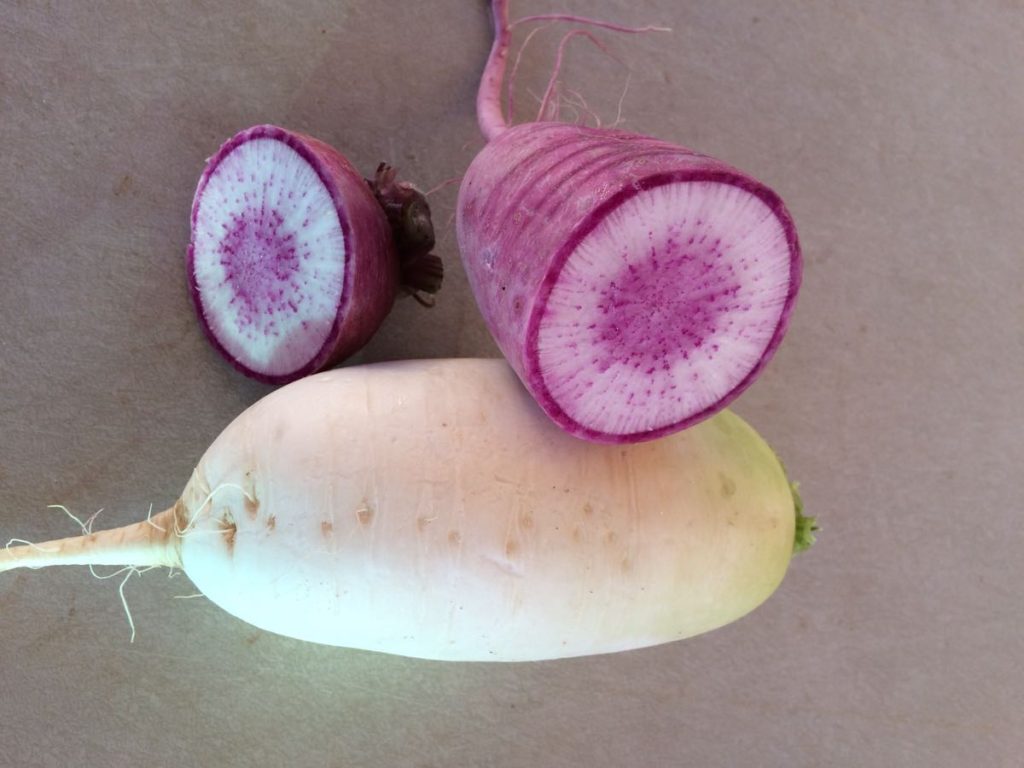
These Korean daikon are beautiful AND milder than usual!
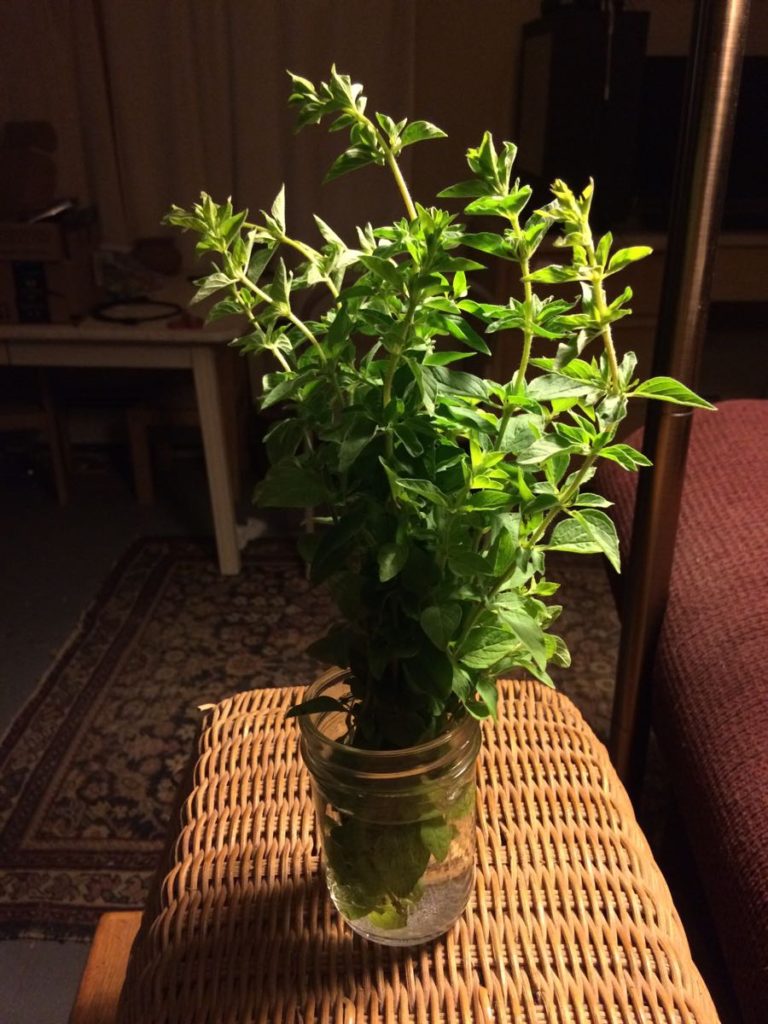
You can store your oregano at room temperature with the cut stems in water. See notes above for other options.
LOCAL THYME RECIPES
Comforting Classics
.
Outside the Box Recipes
.
Quick and Easy Meal
RECIPES FROM LAUREN
PORK, BROCCOLI & SNOW PEA LETTUCE WRAPS WITH PICKLED DAIKON
When I run out of ideas for lettuce, which always happens by late June, I have to get creative. Lettuce wraps are a great solution for when I’m sick of salads but the lettuce is still ultra beautiful and I desperately want to find a way to enjoy it. It’s especially fun if I can fill my lettuce wraps with a bunch of other veggies and top them with pickled veggies. That’s a CSA dream meal! Hope you enjoy! Lauren.
Serves 6-8
Takes 1 hour
2-1/4 cups water
1 cup brown rice
1 tablespoon toasted sesame oil
1 tablespoon olive oil
1 pound ground pork
3 garlic scapes, sliced
1/4 teaspoon Kosher salt
1/4 teaspoon freshly ground black pepper
2/3-3/4# broccoli, stems and florets, roughly chopped into bite-size pieces
1/4 cup tablespoons soy sauce or tamari
2 teaspoons fish sauce (or add more soy sauce or tamari if you don’t have fish sauce)
2 tablespoons maple syrup
1-2 tablespoon sriracha or favorite hot sauce, we used 2 but base it on your own heat tolerance
1 cup cashews
2/3 cup snow peas, stems removed and slicedRed bibb lettuce leaves, for serving
Pickled Daikon:
1/4 cup white sugar
1/2 cup rice wine vinegar
1 tablespoon toasted sesame oil
1 teaspoon Kosher salt
1-1/2# daikon, cut into matchsticks (no need to peel)
- Bring water to a boil over high heat. Add rice, reduce to a simmer, cover and cook for 45 minutes. Turn off heat after 45 minutes but leave the lid on for †an additional 15 minutes.
- Meanwhile, prepare the rest of the meal. To make the pickled daikon, whisk together sugar, rice wine vinegar, sesame oil and salt in a large bowl. Once sugar is dissolved, add daikon. It likely won’t be enough liquid to cover the daikon at first, but give it a good stir anyways. The daikon will release water as they sit there and you’ll wind up with plenty of pickling liquid. Allow to sit for 30-60 minutes, stirring occasionally.
- In a large saute pan (I used my cast-iron skillet), heat sesame and olive oils over medium heat. Add ground pork, garlic scapes, salt and pepper. Cook for 10 minutes until pork is browned. Add broccoli, soy sauce, fish sauce, maple syrup and sriracha to skillet. Cook until broccoli looks tender, about 5-8 minutes. Add snow peas and cashews and cook just for a couple minutes to allow flavors to combine. Add fully cooked rice just before serving.
- Serve a scoop of the rice mixture in a lettuce leaf and top with pickled daikon.
.
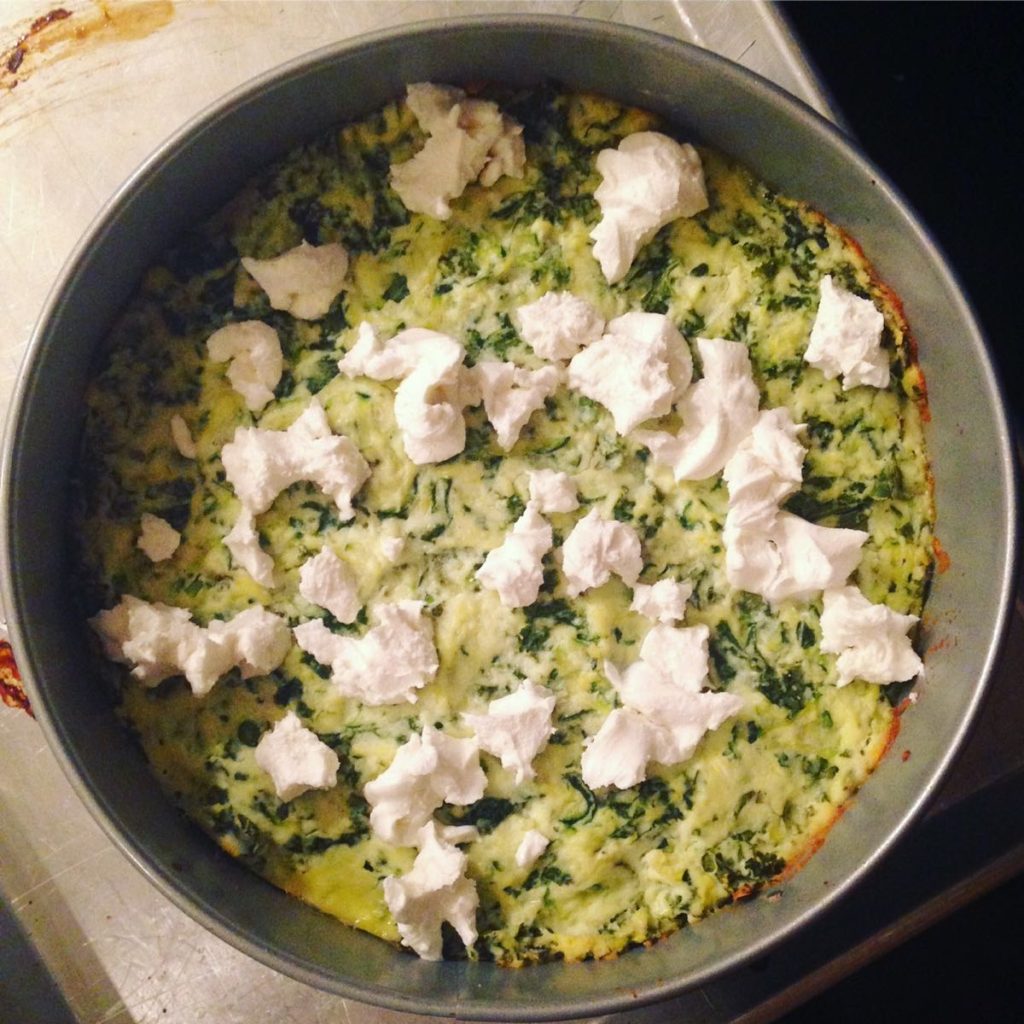
ZUCCHINI & KALE CHEESECAKE
Inspired by 101 Cookbooks
When I came across a recipe for zucchini cheesecake, I couldn’t quite believe it. A savory cheesecake that I can toss veggies and herbs into and serve warm or cold?! A rich hearty dish that’s packed with all my favorite cheeses and can be easily packed up for lunch or for a picnic?! This is a great simple, elegant meal that will surely impress any crowd. Make it for dinner. Make it for brunch. Whatever you do, just make it! Lauren.
Makes an 8-inch cheesecake
Serves 4-6
Takes 2 hours, most of it inactive
2 heaping cups unpeeled zucchini (about 1 large or 2 smaller)
1 teaspoon Kosher salt
3 cups whole-milk ricotta
1/2 cup finely shredded parmesan
2 green garlic, sliced
3 leaves kale, stems removed and torn into bite size pieces
1/4 cup greek oregano, leaves removed and roughly chopped
2 eggs
1/3 cup goat cheese
- Preheat the oven to 325 degrees. Grease an 8-inch spring-form pan. If you don’t have one, a 9-inch pie pan will work fine as well.
- Shred zucchini, toss with salt and place in a colander or fine-mesh strainer or colander. Leave here to drain while you do the next step.
- In a large bowl (or the bowl of your stand mixer), combine ricotta, parmesan, green garlic, kale and oregano. Don’t worry, it should seem like A LOT of kale. Don’t worry, it will cook down while it bakes. Stir to combine. Add eggs and stir until incorporated.
- By now your zucchini should have been draining for 10-15 minutes. Remove from colander and squeeze the water out until about half the original size. You can do this several ways (with cheesecloth, with towels, with a firm spatula in the fine mesh stainer), but I just put it in a ball in my hands and squeezed for about a minute. You don’t have to remove all the liquid. Just a lot of it.
- Add the squeezed zucchini to your ricotta mixture and stir to combine.
- Dump the mixture into your prepared pan and place the pan on a baking sheet (to prevent dripping). Bake for 60 minutes. Remove from oven and dab away any water that has formed on the surface with a paper towel (for me this wasn’t much). Add the goat cheese in crumbles to the top and bake for 35 minutes longer until cooked through.
- Remove from oven, allow to cool slightly and enjoy!
Resilient crew
- On: June 14, 2017
 0
0
Our crew deserves a round of applause for their efforts during this hot, hot week. They persevered in good spirits. As one crew member said, “I am so glad to work with people who take their work seriously, and work hard, and enjoy each others’ company.” All this while picking strawberries on a 94o day.
Basically, we have to forge ahead with our farm work during any weather. We try to be strategic, finishing tough jobs early and saving indoor work (like bundling asparagus) until afternoon. More often, the vegetables dictate the work sequence. Delicate crops like lettuce and spinach have to be harvested in the morning while it’s still cool. Here are just a few of the many things the crew accomplished this week.

They transplanted sweet potato slips, using our 70’s era strawberry planter. We use it twice per year, once for strawberry seedlings, once for sweet potatoes. From left, Kelsie, Kristin, Karen, Michio, Jim, Smitty and Simone (on tractor).

Jory and Maggie (and Billy off-camera) pound wooden stakes in the tomato field. We’ll intertwine string along the posts to support the tomato plants and keep the tomatoes off the ground. This is a very demanding job in the heat but they got it done. You can just see the irrigation running in the distance. Look for a white spurt at the horizon left of Maggie.

Steve ran the irrigation gun every day this week. All the storms sweeping through the area skipped our farm. We hope for rain but will continue to make our own.

Ari picks garlic scapes, one by one. We count each scape, even though we put the scapes in the CSA boxes by the un-counted handful. The scape count is a good predictor of how many garlic heads we’ll harvest in July so it’s worth the extra effort.

We picked a zillion strawberries this week. They ripened quickly in the heat.
Resilient strawberries
We have beautiful, ripe berries for you this week. Quality and flavor are excellent because of the dry weather. (For strawberries, wet weather = rot.) Eat your berries soon; they are ripe and will not store for long.
Strawberries are not resilient plants. This field appears to be the exception. Throughout it’s life, we repeated thought the planting might be lost. Remember how much it rained last summer and early fall? We couldn’t control the weeds in this field. Steve cultivated and the weeds re-rooted in the next rain. The strawberries re-rooted too, erasing the aisles which delineate the varieties. We mulched and headed into winter not knowing if the plants were strong enough to set flower buds. Come February, freakishly warm weather risked breaking the plants’ dormancy. In spring, we irrigated to protect on frosty nights, as usual. By June, we had a mass of berry plants, long wandered out of their rows but bearing excellent quality berries. It is a happy outcome.
Veggie List and Veggie Notes
(June 15/16, 2017, Week #5, purple EOW & sun sampler)
Strawberries, 1 pt + 1 qt
Asparagus, about 3/4 lb
Broccoli, 1.25 – 1.75 lb
Zucchini, 2+ lb
Kohlrabi, 1 large
Spinach, 1 medium bunch
Red bibb lettuce
Some sites will get …
Garlic scapes, a handful
Scallions, 1 small bunch
Some sites will get …
A larger amount of garlic scapes
Next week’s box will probably contain strawberries, peas, broccoli, zucchini, garlic scapes and more.
Strawberries! – We’ve been waiting for these.
♦ Ripe strawberries are perishable. Ripe berries should be eaten immediately, or stored in the refrigerator. Most berries are quite clean. If you want to clean your berries, rinse gently. Don’t soak them, just rinse.
♦ You will receive two containers of strawberries. Compare the containers, judge which berries are softer and more ripe, and eat those first.
♦ Please recycle your strawberry containers. We no longer collect them for re-use. Please don’t return them to your pick-up site.
Asparagus – This is the final delivery. It’s time to let the plants grow and replenish their enormous underground storage roots, accumulating energy to fuel next spring’s harvests.
Broccoli – Refrigerate in a plastic bag.
Zucchini & summer squash – First pick of the season! Zucchini needs refrigeration but does not do well at very cold temperatures, as it will soften and form pits in its surface. Keep these squash in a plastic bag in the warmest part of your fridge.
Kohlrabi (pale green, round vegetable with thick skin) – Crunchy and sweet, kohlrabi is a great addition to salads.
Storage: Kohlrabi bulbs will store for a month in the refrigerator.
Uses: Kohlrabi are good peeled and eaten out of hand, or added to sandwiches. Mix into lettuce or spinach salads, or prepare as a salad on it’s own. You can grate it, slice it, or cut it into matchsticks. It’s also good cooked. If you have it, the Asparagus to Zucchini cookbook has a long list of kohlrabi suggestions.
Red bibb lettuce – This delicate lettuce came through the hot weather beautifully.
Garlic scapes (curly green things) – Garlic scapes grow at the top of garlic plants. They look like flower buds but are actually clusters of tiny bulblets. We snap off the young scapes to direct the plants’ energy into forming garlic bulbs underground. Use scapes as a substitute for garlic cloves. They can be minced, mixed with olive oil, and added to stir fries or simple pasta dishes. If you have a larger amount, puree with oil to form a pesto to add to pasta or line a pizza. The scapes can be sautéed, but will not brown like garlic cloves. Expect them to retain their crunch even when cooked, and to be milder than garlic cloves, closer in pungency to the green garlic we’ve sent. This week’s scapes are from our friend John Hendrickson of Stone Circle Farm who grows organic garlic bulbs for our CSA. Next week, we’ll deliver scapes from our farm and from John.
LOCAL THYME RECIPES
Comforting Classics
Paprika and Oregano Roasted Kohlrabi
Strawberry Buttermilk Pancakes
Rice Noodle Stir Fry with Broccoli, Spinach and Kohlrabi
Shaved Zucchini Salad with Parmesan Dressing
Outside the Box Recipes
Grilled Zucchini and Kohlrabi Sandwich
Red Bibb and Strawberry Salad
Mediterranean Farro with White Beans and Broccoli
Spinach Salad with Dates and Almonds
Quick and Easy Meal
RECIPES FROM LAUREN
ROASTED ASPARAGUS & GREEN GARLIC FARRO SALAD
My instructions as written are best on a day that is less than 90 degrees (a.k.a. requires you to turn on your oven) which lately seems impossible. If you are wanting to make this right away, you could roast the asparagus and green garlic in the toaster oven (as I did) or just saute them gently for 10-15 minutes until tender. I for one love the texture of roasted asparagus (and green garlic). It will always be my technique of choice, even when not weather appropriate. Lauren.
Serves 4 as a side or 2-4 as a hearty breakfast with a fried egg on top
Takes 45 minutes
2 tablespoons olive oil
3/4 pound asparagus
3 garlic scapes
1-1/2 teaspoons Kosher salt, divided
1/4 teaspoon freshly chopped black pepper
1/4 teaspoon red pepper flakes
1 cup farro
2 cups chopped spinach
Fried eggs, for serving
1. Preheat your oven to 400 degrees.
2. Once preheated, drizzle baking sheet with olive oil. Add asparagus and garlic scapes, along with 1/2 teaspoon of the salt and all of the pepper and red pepper flakes. Roast for 20 minutes, tossing after 10 minutes to cook evenly.
3. While the asparagus and scapes roast, bring a large saucepan of water and 1 teaspoon Kosher salt to a boil.
4. Meanwhile toast your farro in a large saute pan for 5 minutes until it browns slightly and begins to smell nutty. Add the farro to your boiling water and simmer gently for 12 minutes. I always cook farro like pasta for the best success. It will be perfect and tender everytime (without getting mushy). Drain after 12 minutes and return to pot. Stir in spinach while farro is still warm and stir just to wilt.
5. Remove asparagus and scapes from oven and preheat to 500 degrees. Roast 5-10 minutes longer until charred and a little crispy in spots. Remove from oven and dice asparagus into bite-size pieces. Slice scapes into little coins. Toss asparagus and garlic scapes with farro to combine.
6. Eat the farro and veggies as is or serve with fried eggs for a more complete meal.
.
THE BEST BROCCOLI SALAD
I love broccoli salad. I didn’t grow up liking it very much (or even understanding it really), but man oh man, do I love it now. It is the first thing I make every year when I receive the first broccoli of the season. This recipe uses other items in your box but can be easily customized with onions, shallots, regular garlic, green garlic or any other allium you have on hand if you don’t have scallions in your box. The addition of kohlrabi also isn’t required (but I love it!). My mom used to make it with pieces of bacon (which you should totally try if you aren’t vegetarian and have never had it that way!). You can use Greek Yogurt instead of the mayo or buttermilk (or both!). You can change up the nuts. Leave out the dried fruit if that isn’t your thing. This is a very versatile salad so feel free to play around with it. Hope you enjoy! Lauren.
1/2 cup diced pecans
1 head broccoli, stem removed, florets cut into bite-sized pieces
1 large kohlrabi, peeled and diced
1 bunch scallions, sliced (you can use all of it, white and dark green parts)
1/2 cup dried cranberries
Dressing:
1/2 cup buttermilk
1/2 cup mayonnaise
2 tablespoons apple cider vinegar
1 tablespoon sugar
1/2 teaspoon Kosher salt
1/4 teaspoon freshly ground pepper
1. In a large saute pan, toast pecans (or whatever nut you decide to use) for 5-10 minutes until browned and smelling really delicious.
2. In a large bowl, combine broccoli, kohlrabi, scallions, dried cranberries and toasted nuts.
3. In a small bowl (or Mason jar with a lid that will be shaken) combine all dressing ingredients and whisk (or shake) until well-combined. Pour over veggies and stir to combine. It takes the veggies a little while to soak up the dressing so try to make it an hour ahead or the day before.
Week #4, June 8 2017
- On: June 07, 2017
 0
0

A beet and carrot field in the evening sun.
Steve is committed to better weed control this spring. Weeding tends to get neglected during the spring hustle to get crops in the ground. This year, we’ve got new cultivating tools, more employees with tractor cultivation experience, and a stronger commitment to putting the weeding first on the schedule. If left to the end of the day, it doesn’t get done. We’ve even got a new Dutch harrow on the way to the farm. We’ve had mixed experiences importing machinery from Europe so let’s all keep our fingers crossed here are no hitches.
Beginning last year, we stopped growing spring lettuce for our wholesale customers (Willy Street, Outpost, Basics, etc) in hopes the change would free up more time to get our spring crops established. We plant most of your CSA vegetables during the months of May and June, so it’s a very important period. Blink and you can lose a field to weeds. The change did not go as planned last year. Steve was still recovering from a bike accident the previous fall. His energy was low and he didn’t keep the farm organized and running on a schedule. He’s much improved this spring and our whole farm is functioning better. The result is pretty fields like in the photo. Beth
Veggie List and Veggie Notes (week#4, June 8/9, 2017)
Napa cabbage
Spinach, 1st big bunch
Spinach, 2nd big bunch
Asparagus, about 1 lb
Red Romaine lettuce (some sites get red bibb)
White salad turnips, 1 bunch
Radishes, 1 bunch
Red scallions, 1 bunch
Next week’s box will probably contain strawberries, asparagus, spinach, lettuce, scallions, garlic scapes and more.
Napa cabbage (large, pale green cabbage with crinkled leaves) – This week’s napa average 2.75 lb in size. This is an interesting vegetable, useful for both fresh, raw salads and for cooking. Napa’s most famous use is fermented kimchi. I like to prepare a fresh, unfermented kimchi. Same seasonings, but it’s ready to eat right away. You will be amazed at how much shredded napa cabbage shrinks when prepared this way. See here for an example, but cut the salt in half: Grilled Flank Steak with Kimchi-style Coleslaw.
Storage: Napa stores very well. Cut off wedges as needed and keep the rest covered and refrigerated, and it will keep for several weeks. Peel off the outer layer and it will be ready to use. Here are a few preparation ideas from the ‘Asparagus to Zucchini’ cookbook.
– Chop raw napa into green salads.
– Substitute napa in traditional coleslaw.
– Chinese cabbage cooks quickly. Steam 3-5 minutes, or until leaves are wilted down but remain slightly crisp.
– Substitute napa cabbage for common cabbage in recipes, but reduce the cooking time by 2 minutes.
– Napa cabbage is the main ingredient in egg rolls. Try making an egg roll mixture to eat as a cooked side dish instead of preparing time-consuming egg rolls.
Spinach – That’s not a typo; you will receive two bunches of spinach this week. We are sharing lots this week while it is lush and abundant. Total combined weight for the 2 bunches will be about 2 lb. This is a good week to try cooked recipes, as spinach shrinks substantially when cooked.
To freeze; Frozen spinach is so useful – add to lasagne, casseroles, quiches, soups. Spinach needs blanching before freezing. Wash well, chop coarsely, and place in a large pot with 1 inch of water in the bottom. Steam until the color changes, stirring a few times. Turn off heat, return cover to the pot, wait a few minutes and stir again. The residual heat will finish the cooking. The spinach should be completely collapsed. Cool, then pack into containers. Choose a container sized to the amount you will want to thaw later.
Asparagus – Some of you will get very short asparagus this week. The asparagus field needs weeding midway through the harvest season. We pick the field very short, then mow down the weeds. It’s a quick fix that lets us keep picking for another week or so. Once the weeds get too tall we can’t find the asparagus spears. We’ll do a more thorough weeding once the harvests are finished.
Salad radishes – Uses: Traditionally, radishes are sliced thinly and added to salads. If you dislike radish spiciness, slice and toss with salt in a bowl. Let sit for 10 minutes, then rinse. Radish sandwiches on buttered bread are surprisingly good. I first enjoyed them as part of an appetizer platter at the Coopers Tavern. This recipe uses too much butter but you’ll get the idea. All you need are good quality radishes, good quality bread and good quality butter. Don’t forget the salt.
Storage: To store, cover and refrigerate. To maximize the life of your radishes, remove and discard the greens.
Red scallions – Steve tried this variety just because they are pretty. Use like normal scallions. We don’t know yet if the color will change with cooking but we’ll find out soon with a batch of scallion biscuits. That’s a spring favorite in our household.
RECIPES
See the RECIPE LOG for recipes from previous weeks. There are dishes for asparagus, spinach, lettuce, scallions, turnips, and radishes that might be useful with this week’s produce.
Local Thyme Recipes
Comforting Classics
Turkey or Hummus and Radish Wraps with Spinach Pesto
Seared Sesame Asparagus
Chinese Cabbage Salad with Radish and Crispy Ramen Noodles
Marcella’s Slow Cooker Stuffed Cabbage Rolls
Outside the Box Recipes
Chicken Valdostana Over Braised Lentils
Grilled Pizza with Fig, Asparagus and Scallions
Warm Napa Cabbage Slaw with Dill
Chinese Tofu or Chicken and Cabbage Noodle Soup
Quick and Easy Meal
Salmon with Shaved Asparagus and Radish Salad
Recipes from Lauren
CRUNCHY NAPA CABBAGE & PEANUT RICE BOWL
Adapted from Bon Appetit magazine
Now this, this dish serves a crowd. It’s a great vegan, gluten-free (if you use the tamari instead of the soy sauce) dish to bring to a party or to make on a Sunday to have in your fridge for lunches all week long. Napa cabbage and peanut sauce is one of my absolute favorite combinations. I hope you enjoy!
Takes 1 hour
Serves 8-12 (even more if eaten as a side dish only)
4-1/2 cups water
2 cups brown rice
1 teaspoon Kosher salt
1 head Napa cabbage, cleaned and thinly sliced (I slice the white stem and green leafy portion together)
1 bunch radish, greens removed, cut in half and thinly sliced
1 bunch turnips, greens removed, cut in half and thinly sliced
1 bunch scallions, sliced (you can use all of the scallion, whites, pale green and dark green portions)
Roasted peanuts, chopped, optional
Warm Peanut Sauce:
1 cup creamy peanut butter
3/4 cup coconut milk
2 tablespoons brown sugar
2 tablespoon soy sauce or tamari
Juice from 1 lime (or 2 tablespoons lime juice)
1 tablespoon fish sauce
1/2 teaspoon red pepper flakes
Kosher salt
1/4 cup water
- Bring water to a boil in a large saucepan on the stove top over high heat. Once boiling, add rice and salt and reduce heat to low. Cover and cook for 50 minutes (or less, depending on your type of rice; read the package directions).
- While the rice cooks, prepare your veggies. In a (seriously really) large bowl, toss napa cabbage, radishes, turnips, and scallions together. Add a pinch or two of sauce and toss veggies so evenly distributed. Set aside.
- When the rice has about 10 minutes left to cook, begin the sauce. Combine peanut butter, coconut milk, brown sugar, soy sauce or tamari, lime juice, fish sauce and red pepper flakes in a large saucepan. Whisk together until smooth. Place on stove and turn heat to medium. Add a pinch of salt and water. Whisk until smooth and hot. You will want the dressing to be warm to wilt the greens.
- Serve in a bowl with the ratio of about a 1/2 cup of rice and 2 cups of veggies. Pour 2-3 tablespoons of peanut sauce over the greens and toss gently to coat. Add peanuts if you like. (I didn’t use them but could see how they’d add a great crunch).
.
SHAVED ASPARAGUS & SPINACH CAESAR SALAD
If you have never before shaved asparagus you are in for a real treat. The thin ribbons can be tossed into things like pasta or quiches. I also love it on pizza ala Smitten Kitchen. But I especially love shaved asparagus raw. It has a wonderful texture and adds a lot to simple salads. With the red romaine, this salad will be a vibrant and beautiful dish to serve alongside any meal.
Please note for this recipe, you will be making Caesar dressing from scratch. If that’s not your thing and the word emulsify scares you, feel free to buy a high quality Caesar (it will likely be in the refrigerator section of your grocery store) and use that instead. If you plan to make the dressing, but are freaked out by raw egg yolk, you can substitute 2 tablespoons of mayonnaise instead. Lauren.
Beth’s note. We don’t eat raw eggs in our house. Use bottled dressing, or Lauren’s mayo substitute, or buy pasteurized eggs at the grocery store. If you hunt around online, you can find food scientist Harold McGee’s method to pasteurize egg yolks in the microwave.
Takes 30 minutes
Serves 4-6
1 pound asparagus
1 pound spinach, chopped
1 head red romaine, roughly chopped
1/2 cup finely grated Parmesan
4 cups croutons, store-bought or made from scratch
Caesar Dressing:
Juice of 1 lemon (or 2-3 tablespoons)
1/2 teaspoon garlic powder (or 2 teaspoons minced green garlic if you have some leftover)
1 teaspoon Kosher salt
1/2 teaspoon Worcestershire sauce
2 large egg yolks
5 tablespoons vegetable oil
5 teaspoons extra-virgin olive oil
1/2 cup finely grated Parmesan cheese
1/2 teaspoon freshly ground black pepper
- Shave your asparagus! You will do this with a standard vegetable peeler. It works best for me when I lay the asparagus close to the edge of the counter. One hand holds the crown of the asparagus to keep it from moving and the other holds the peeler shaving off ribbons until about half of the asparagus is gone. Then I flip over the asparagus and continue until the peeler can’t go any further. You will have uneven pieces but that’s totally fine. Feel free to snap any larger pieces in half. This process is a little tedious so once you get the hang of it, you can do two or three pieces of asparagus at a time to speed things up.
- Toss the asparagus into a bowl with the lettuce and spinach.
- Now prepare you dressing. Whisk two tablespoons of lemon juice and garlic together in a large bowl. Let sit for 5 minutes. Add Worcestershire, salt and egg yolks into lemon mixture. Slowly whisk in each batch of oil until well-incorporated. Start slow, drop by drop, then start adding more at a time, consistently whisking throughout the additions. You are looking to emulsify the dressing (this means the oil and vinegar will no longer be separate and the mixture will become thick, creamy and glossy as you whisk). Add the Parmesan cheese and pepper, whisking again to combine. Taste and adjust seasonings by adding more salt, pepper or lemon juice.
- Toss the asparagus and greens with the dressing. Or, if you don’t plan to eat it all tonight, toss just as much of the veggies with dressings as you plan to eat. Top with a dusting of Parmesan and the croutons. Feel free to add chicken breast or an egg to make it a complete meal.
.
Entertaining visitors
- On: May 31, 2017
 0
0
Our weekend was devoted to entertaining visitors, in both meanings of the phrase. Sophie’s graduation and party were big successes. Our families extended their visit so we brainstormed ways to entertain our urban (Steve) and suburban (Beth) relatives and show them a bit of Wisconsin life. Keep these ideas in mind next time you have visitors.
Green County Dairy Breakfast
The annual dairy breakfast was just down the road this past weekend. It’s a slice of Wisconsin life: breakfast, farm tours, arts & crafts, antique tractor displays, petting zoo, educational stations and a live band. I assured Steve’s bachelor brother that all the local dairy queens would be in attendance. Breakfast was eggs, sausage, cheese, coffee cake, orange juice, coffee, and strawberry sundaes. Local families contribute homemade coffee cake, all using the same recipe and dropping their cakes off at local banks in Albany or Monticello for collection.

It was a beautiful day (finally) so turnout was good.

Instead of a sandbox, there’s a box filled with shelled corn. Those kids went home with pockets, underwear and hats filled with kernels.

Steve’s brother Nate with the calves.
Below is the coffee cake recipe used by the volunteer bakers.
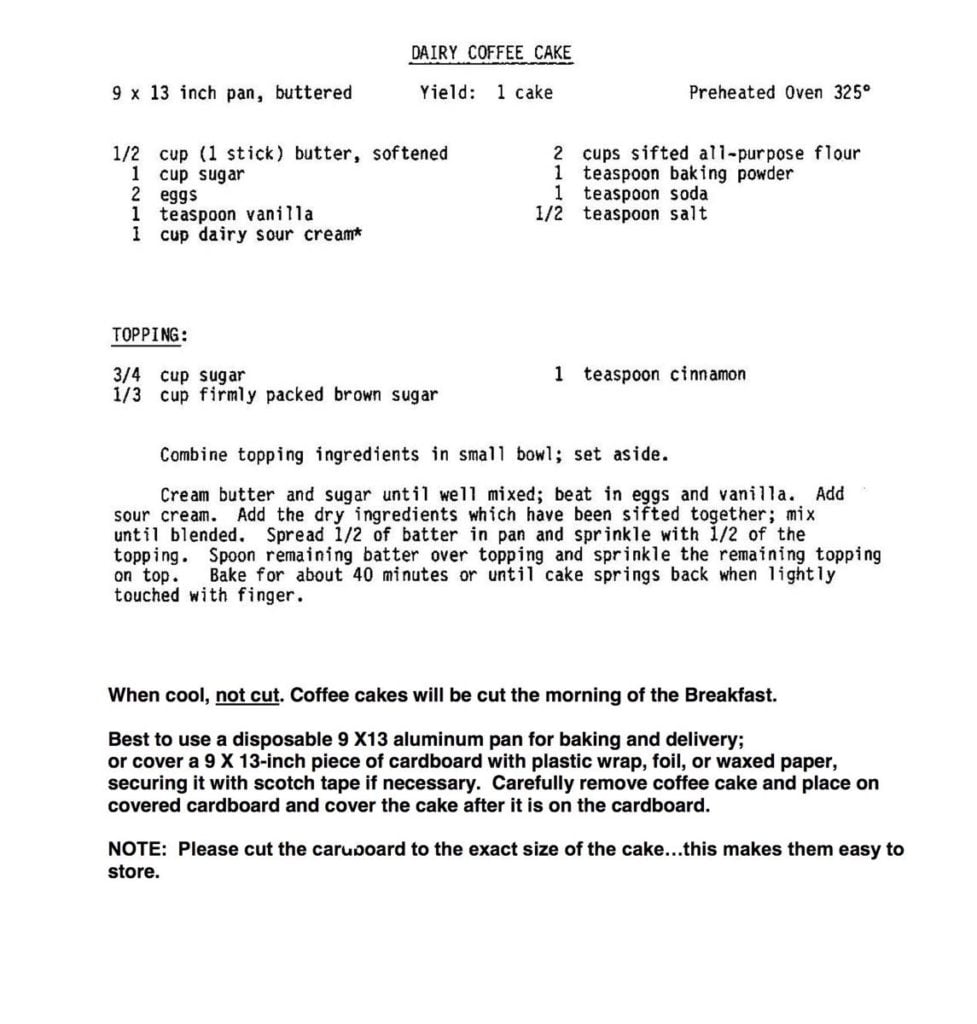
Explore a State Natural Area (SNA)
Wisconsin has amazing State Natural Areas, “outstanding examples of Wisconsin’s native landscape of natural communities, significant geological formations and archeological sites.” The DNR’s Wisconsin Natural Resources magazine features a tempting photo of a different SNA on the back of each issue. Of course this lovely self-funded magazine is on the chopping block. Subscribe today. My favorite SNA is Muralt Bluff, just 20 minutes west of our farm. It is short-grass prairie, up on a ridge that just escaped the glacier’s edge 10,000 years ago. The density of native plants is remarkable. My mom turned 80 the day after our hike so I am very proud of her and my dad for getting up on the bluff.

From front, my aunt Cathy, father Jack, mother Rose and uncle Tom.
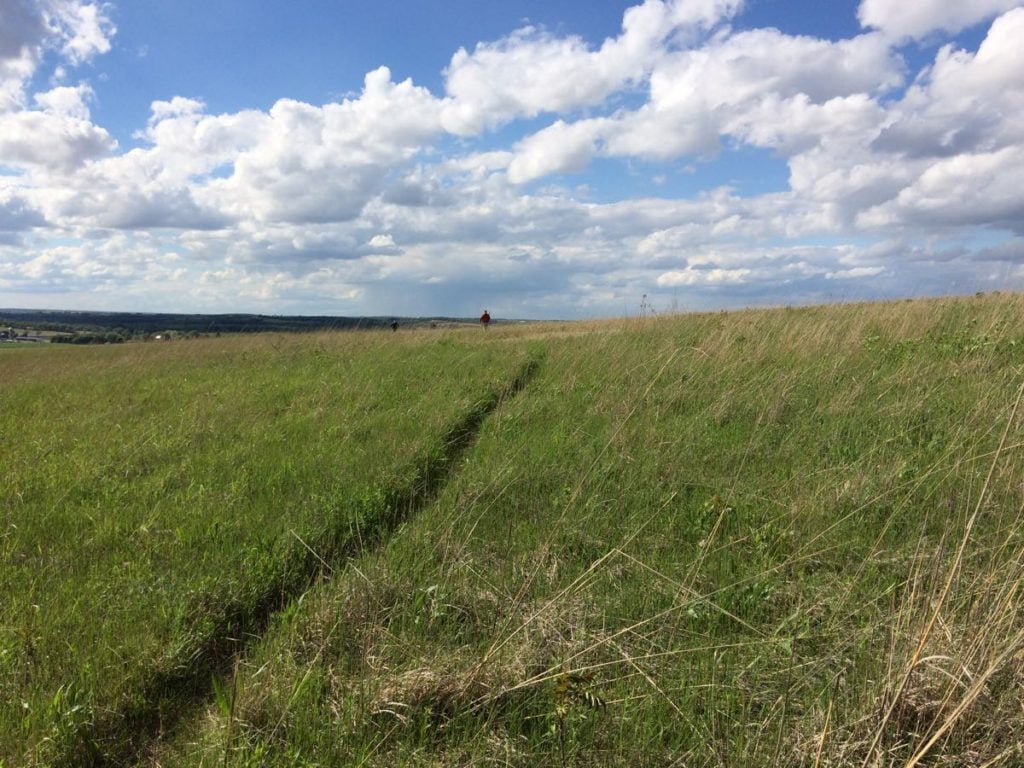
As my mom said, it seems like we’re closer to the clouds up on the bluff.
Beth
June 1 checks
Many of you paid us with checks post-dated to June 1. We will deposit those checks next week, on June 5 or 6.
Veggie List and Veggie Notes
This week’s produce will be much less muddy than last week but still needs careful washing, a remnant of rains over the past few weeks. However, it is much better than last week. Sampler share members, we provide detailed information about a vegetable the first week we pack it in the CSA boxes. Review the previous newsletters for this info.
Asparagus, 0.9 lb
Escarole
Portobello mushrooms, about 8 oz
Spinach, 1 bunch
Red bibb lettuce
White salad turnips, 1 bunch
Salad radishes, 1 bunch
Scallions, 1 bunch
Green garlic, 1 bunch
Next week’s box is likely to contain asparagus, napa cabbage, spinach, lettuce, scallions and more.
Escarole (large head of wavy green leaves) – This member of the chicory family can be eaten raw or cooked. Its slightly bitter flavor is a good addition to mixed salads. It is excellent cooked alone or mixed with other greens. It cooks quickly, but not as quickly as spinach. Cover and refrigerate.
Portobello mushrooms – These beauties are from Mary at Hidden Valley Mushrooms in the Wisconsin Dells. We will pack them in brown paper bags. Mary says to store them in your fridge in the paper bag. Eat soon; they are fresh, lovely and perishable.
Red bibb lettuce – This is my favorite type of lettuce. Bibb lettuce is tender and yummy. Handle gently. Enjoy.
Scallions (bundle of green onions) – These are useful raw or cooked. Thinly-sliced raw scallions can be folded into biscuit dough or sprinkled on top of soups or salads. Terrific garnish for pasta dishes. Think pad thai. We will send both scallions and green garlic so see photo below.
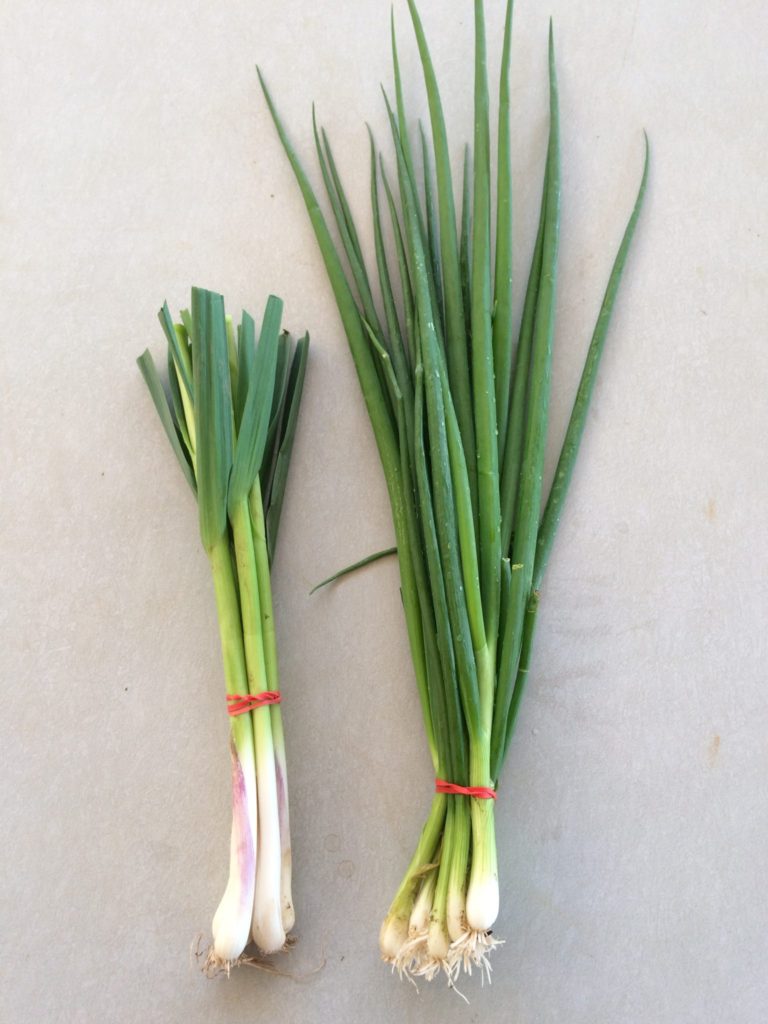
Green garlic (left) and scallions (right) look so much alike! Distinguish them this week by whether the leaves are trimmed (green garlic) or untrimmed (scallions). They smell very different too. However, it’s not a crime if you interchange them in recipes. The green garlic leaves are increasingly fibrous; use just the white and pale green sections. You can use scallions all the way to the tips.
RECIPES
See the RECIPE LOG for recipes from previous weeks. There are dishes for asparagus, spinach, mushrooms, lettuce and radishes that might be useful with this week’s produce.
Local Thyme Recipes
Comforting Classics
Braised Escarole
Grilled Chicken, Radish and Turnip Salad with Scallion Vinaigrette
Mushroom, Spinach and Fontina Lasagna
Soy and Butter Braised Salad Turnip with Spinach
Outside the Box Recipes
Escarole and Semolina Soup
Radish, Turnip and Smoked Trout Salad with Wasabi Vinaigrette
Beans, Radish, Turnip and Spinach Enchiladas
Quinoa Salad with Radishes, Salad Turnips, and Green Garlic Dressing
Quick and Easy Meal
Thai Red Curry
Recipes from Lauren
PORTOBELLO, GREEN GARLIC & SPRING GREENS LASAGNA WITH WHITE SAUCE
Inspired by the great Ina Garten
If you want to use your spinach or escarole for another use, feel free to just toss one of these greens into this lasagna. It won’t change the end result too substantially. If you have extra turnip greens or arugula from last week, they could be substituted as well.
Takes 1 hour, 30 minutes
Serves 6-8 depending on your appetite
Kosher salt
12 tablespoons butter, divided
1/2 cup flour
4 cups warm milk (whole preferred, but 2% will work fine), I throw mine in the microwave for 60†seconds to warm it
Freshly ground black pepper
3/4 pound dried lasagna noodles (or 12 noodles)
2 green garlic, white and light green parts only, minced
1/2 pound portobella mushrooms, cleaned, stems removed, and sliced 1/4-inch
1 bunch spinach, roughly chopped (about 2-3 cups)
1/2 head escarole, roughly chopped (about 3 cups)
1/4 cup water
1-1/2 cups freshly shredded Parmesan
- Preheat the oven to 375 degrees.
- Bring a large pot of salted water to a boil.
- While waiting for the water to boil, begin your white sauce. Melt 8 tablespoons of butter in a large saucepan over medium low heat. Once fully melted, add the flour and stir constantly with a whisk for 1 minute. Pour in the warm milk, 1 tablespoon Kosher salt, 1 teaspoon black pepper and†whisk consistently for 15-20 minutes, scraping the bottom and edges of the pan occasionally, or until mixture is thickened. Remove from heat.
- By now, your water is likely boiling. Add the lasagna noodles and cook for 10 minutes or until al dente. Strain, toss with olive oil in colander and set aside.
- Meanwhile, melt remaining butter in a large saute pan over medium heat. Add green garlic and saute for 3-5 minutes until fragrant. Add mushrooms and sprinkle with salt and pepper. Cook for about 3 minutes until just beginning to release their juices. Add the greens and water and cook until wilted, about 5 minutes longer. There will likely be a lot of liquid in the pan. That’s fine.
- In a 9×13-inch pan, begin to layer the lasagna. First spread about a 1/2 cup of sauce on the bottom of the pan, just enough to cover it followed by three noodles, overlapped slightly. Add 1/4†of the remaining sauce followed by 1/3 of the mushroom mixture, and 1/4 cup of parmesan. Continue this layering two more times: noodles, sauce, mushroom mixture and parmesan. Finishing with a fourth layer of noodles, the remaining sauce and cheese.
- Bake the lasagna for 45 minutes, until the top is browned and bubbly. Let set for 15 minutes before diving in. Serve with a simple green salad or some roasted asparagus.
.
COLD SOBA NOODLE SALAD WITH RADISHES & TURNIPS
Inspired by a recipe in the Near & Far cookbook by Heidi Swanson
This is a great simple side dish for a potluck or to make on the side of some grilled pork chops for dinner. I love cold noodle salads and this one that’s heavy on the veggies is a light, bright tasty spring dish!
Takes 20 minutes
Serves 4
Kosher salt
8 ounces dried soba noodles
1 bunch radishes, greens removed
1 bunch turnips, greens removed
1 bunch scallions, sliced, white and pale green parts only
1/2 cup extra virgin olive oil
1/4 cup rice wine vinegar
1 tablespoons honey or maple syrup
1/2 teaspoon ground coriander
1 teaspoon paprika
1 tablespoon toasted sesame seeds
- Bring a large pot of salted water to a boil over high heat. Once boiling, cook the soba noodles according to package directions. Drain and rinse under cold water until cool.
- While the noodles cook, prep your radishes and turnips. You’ll want to sliver them. The smaller the pieces, the better. To do this, I cut a bit off the top where the green was and then set the radish or turnip on that flat surface. Then cut the radish or turnip into 8 or 12 pieces depending on the size as you would cut a pizza or a pie.
- In a small bowl, toss the radishes and turnips with scallions and 1/4 teaspoon Kosher salt. Set aside.
- In a large bowl, combine olive oil, vinegar, honey or maple syrup, coriander and paprika. Whisk until well combined. Add noodles and toss to coat with tongs. Add radishes and turnips and toss to combine.
- Sprinkle with sesame seeds. Serve at room temperature or cold.
.

